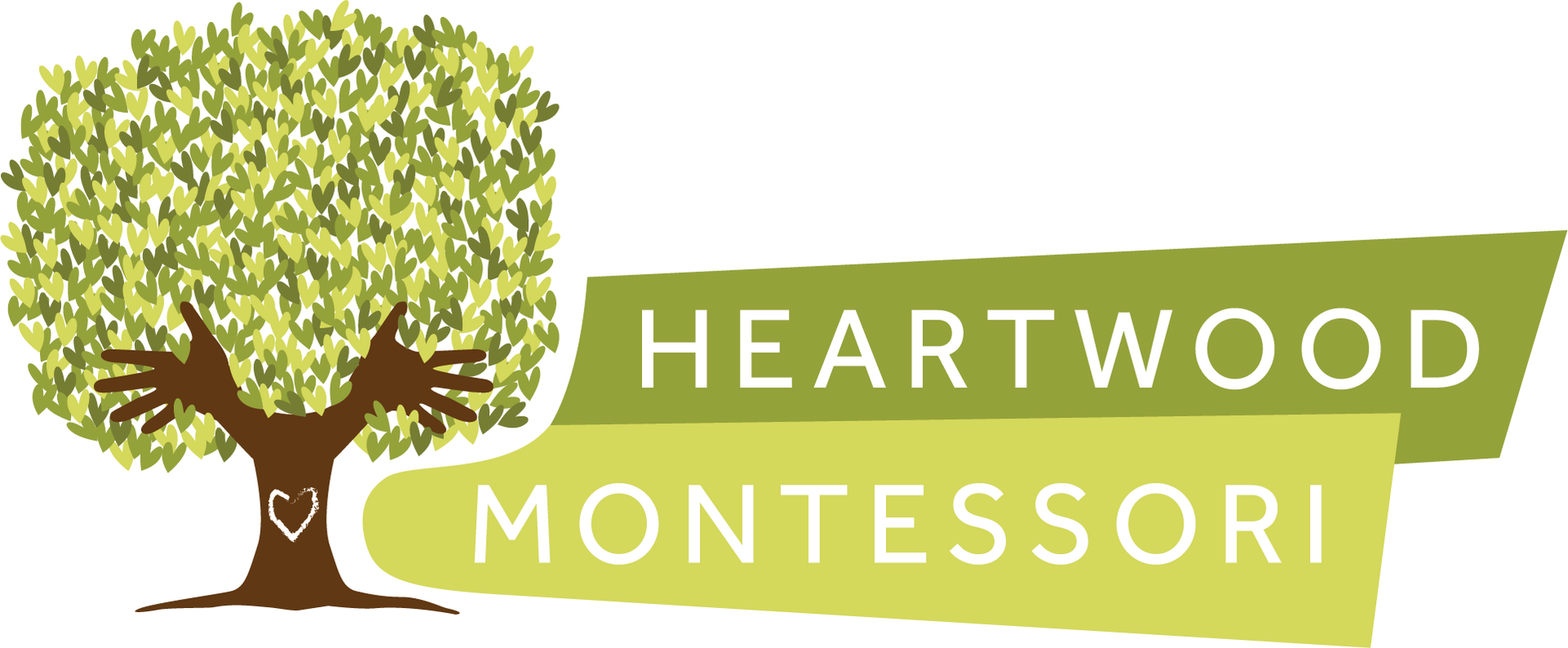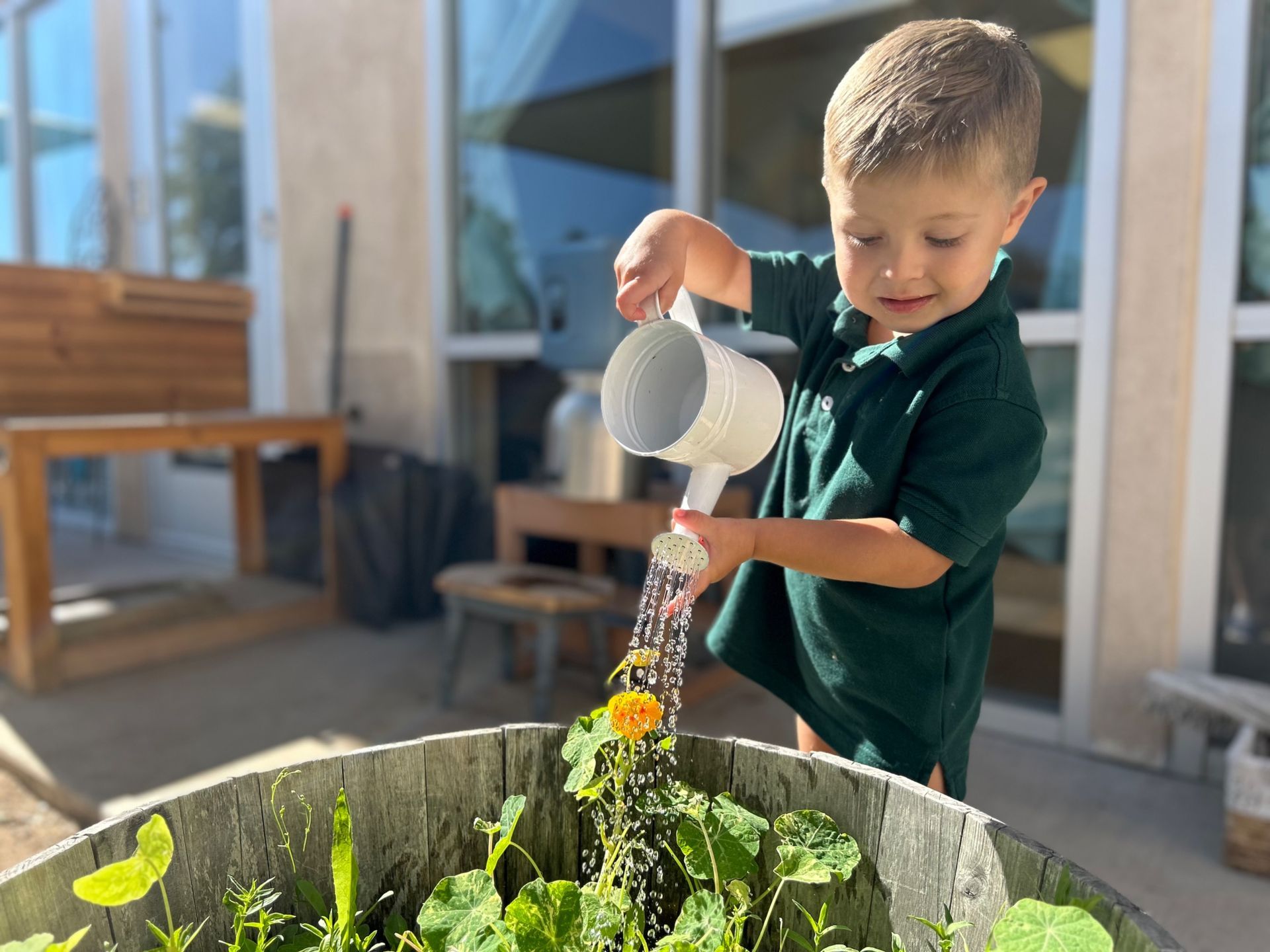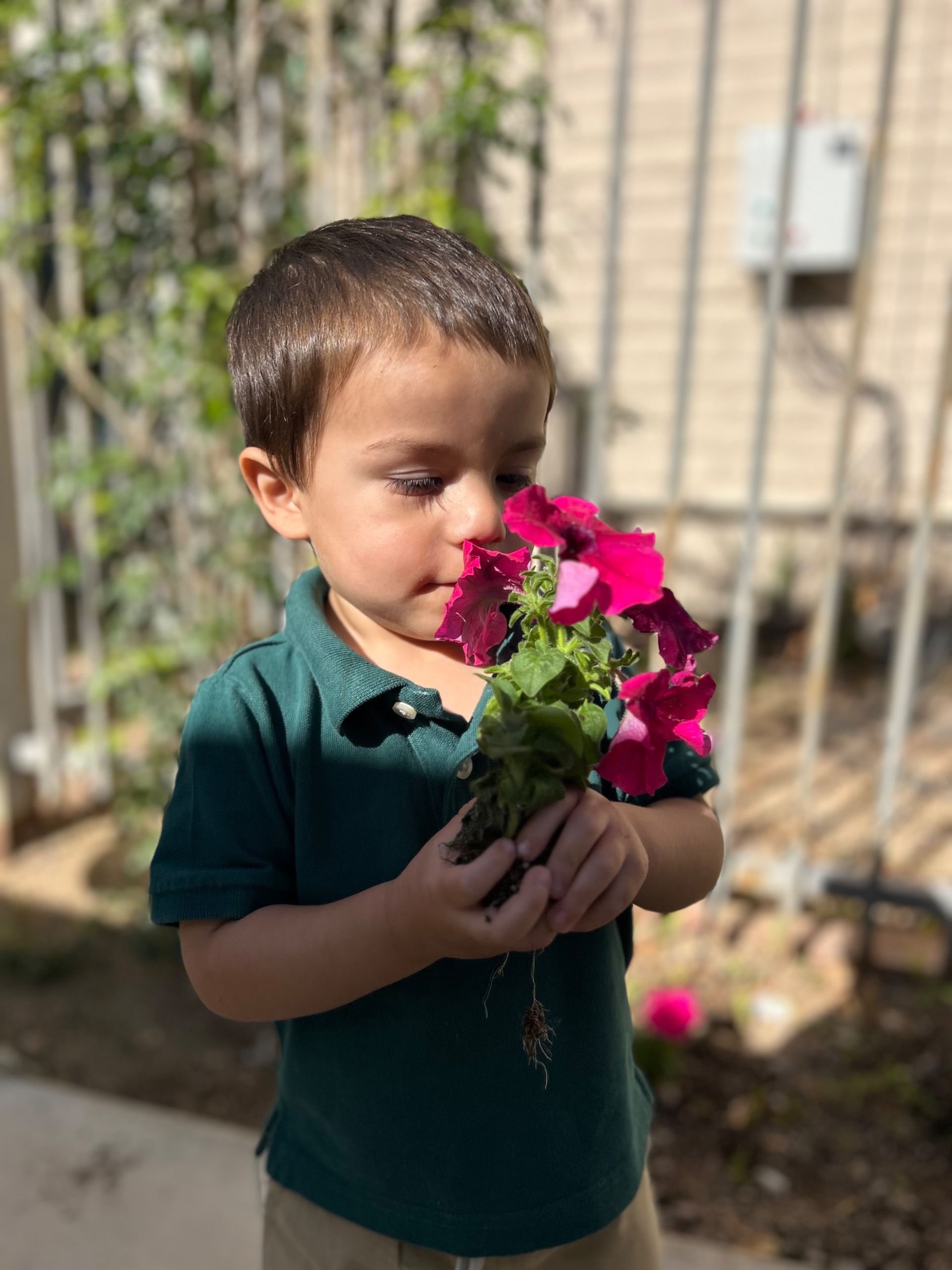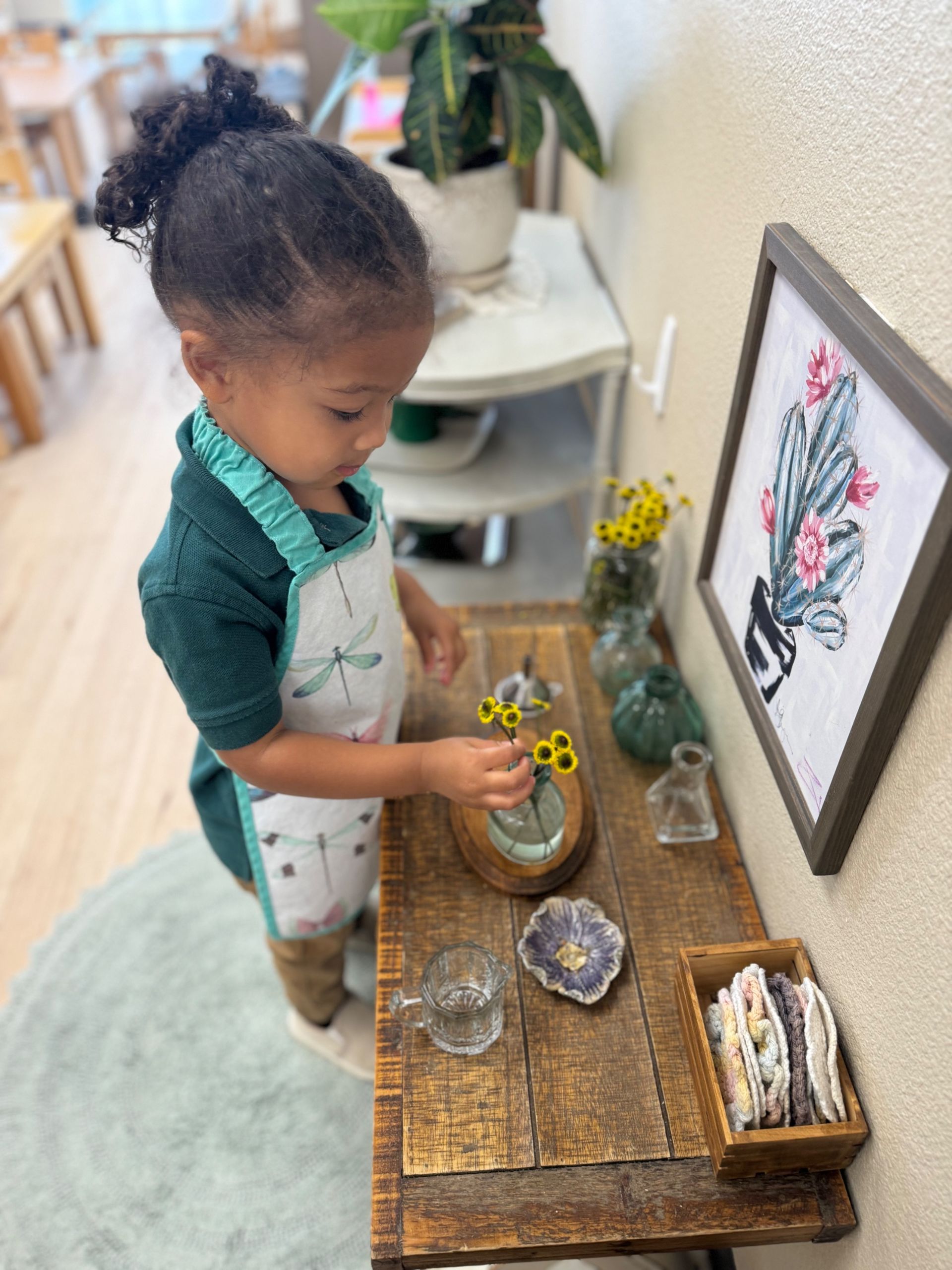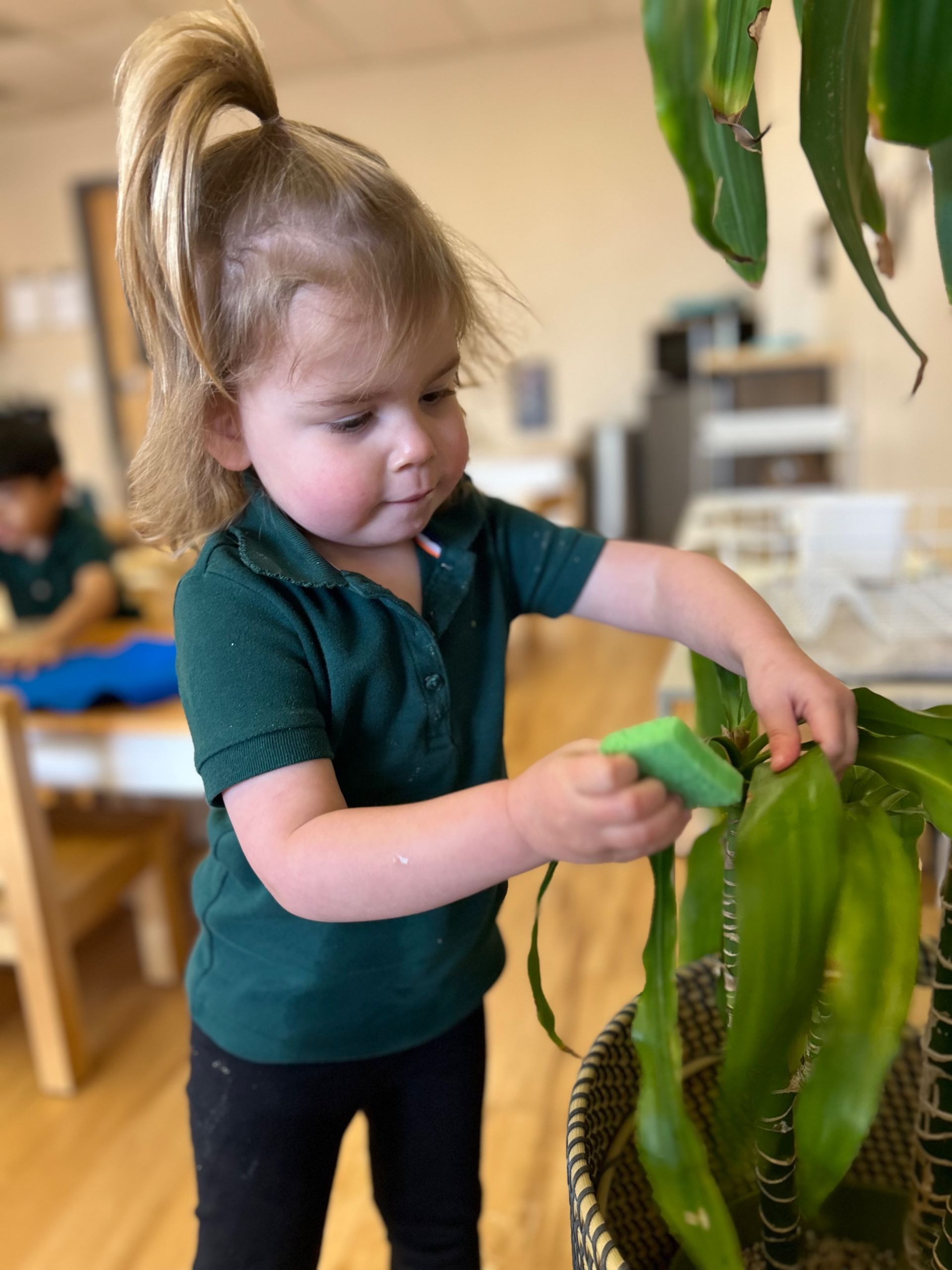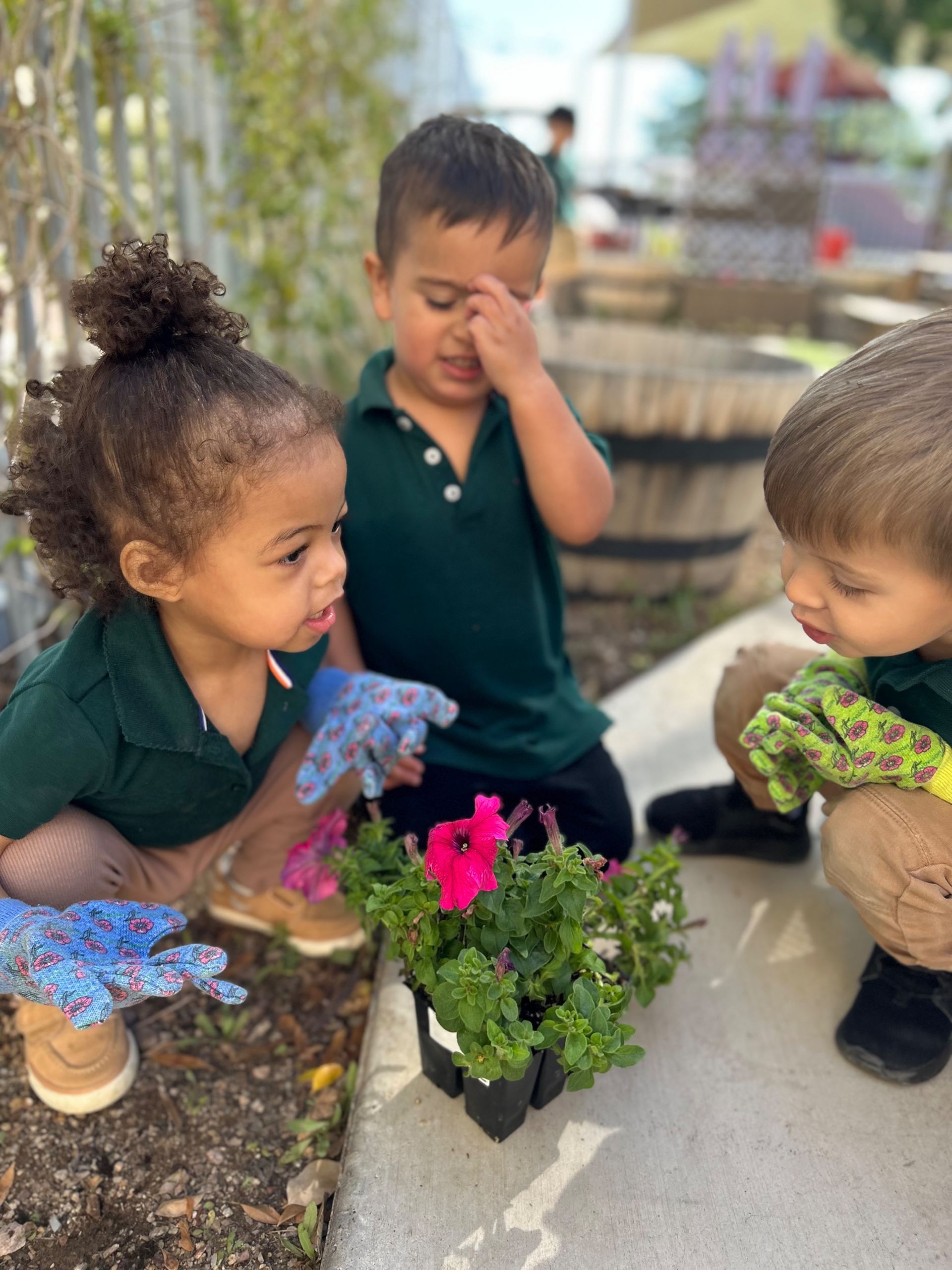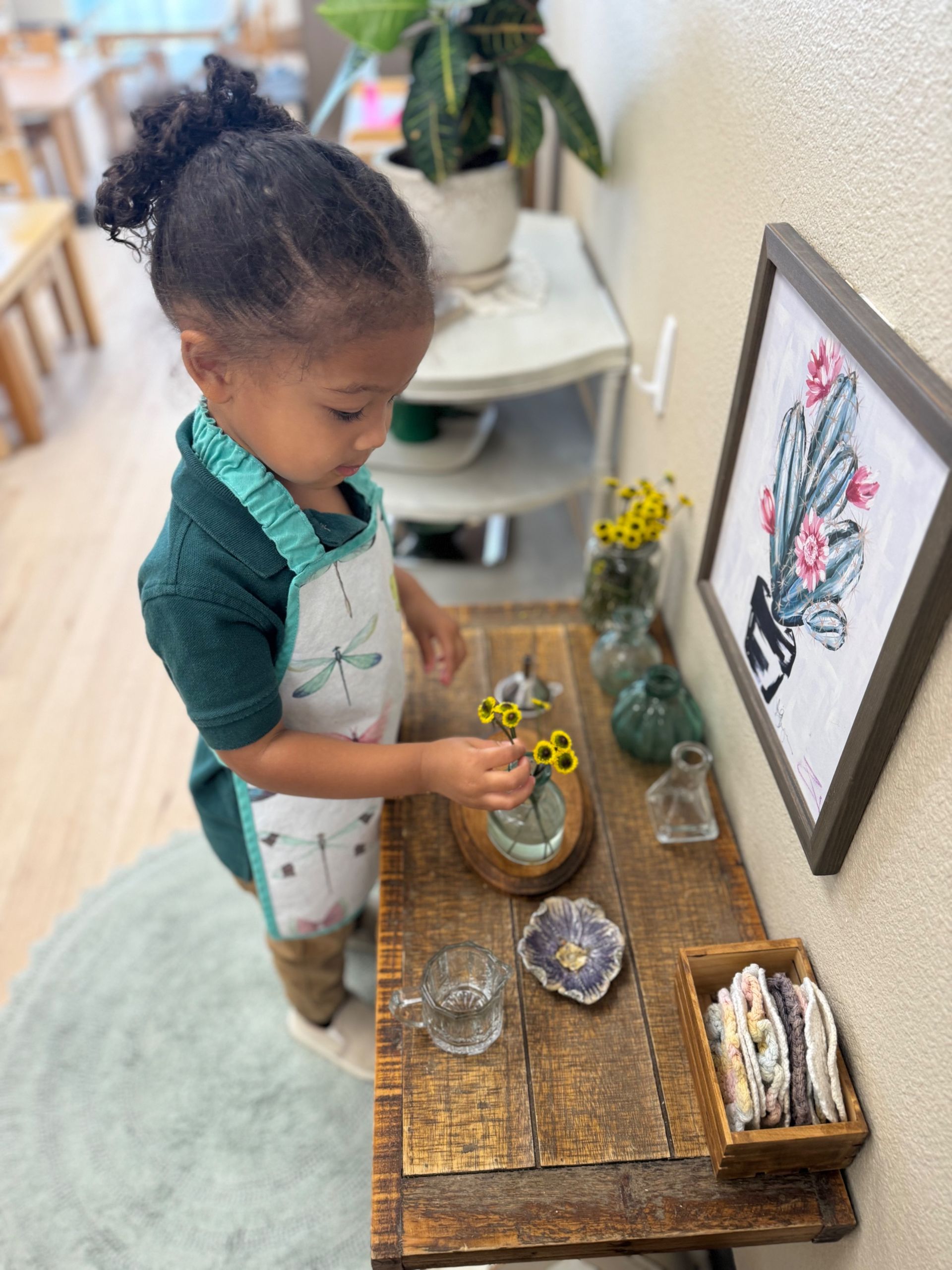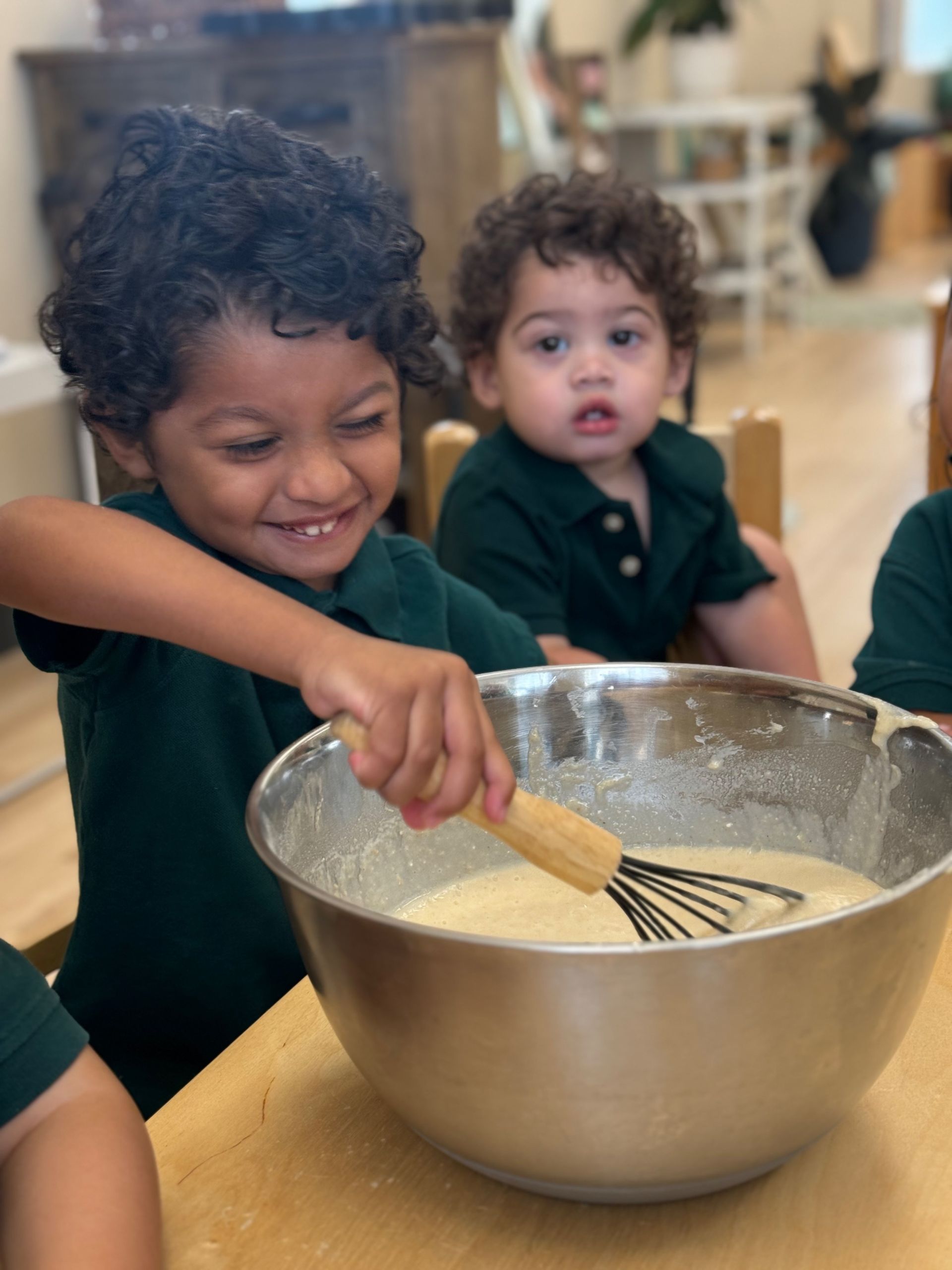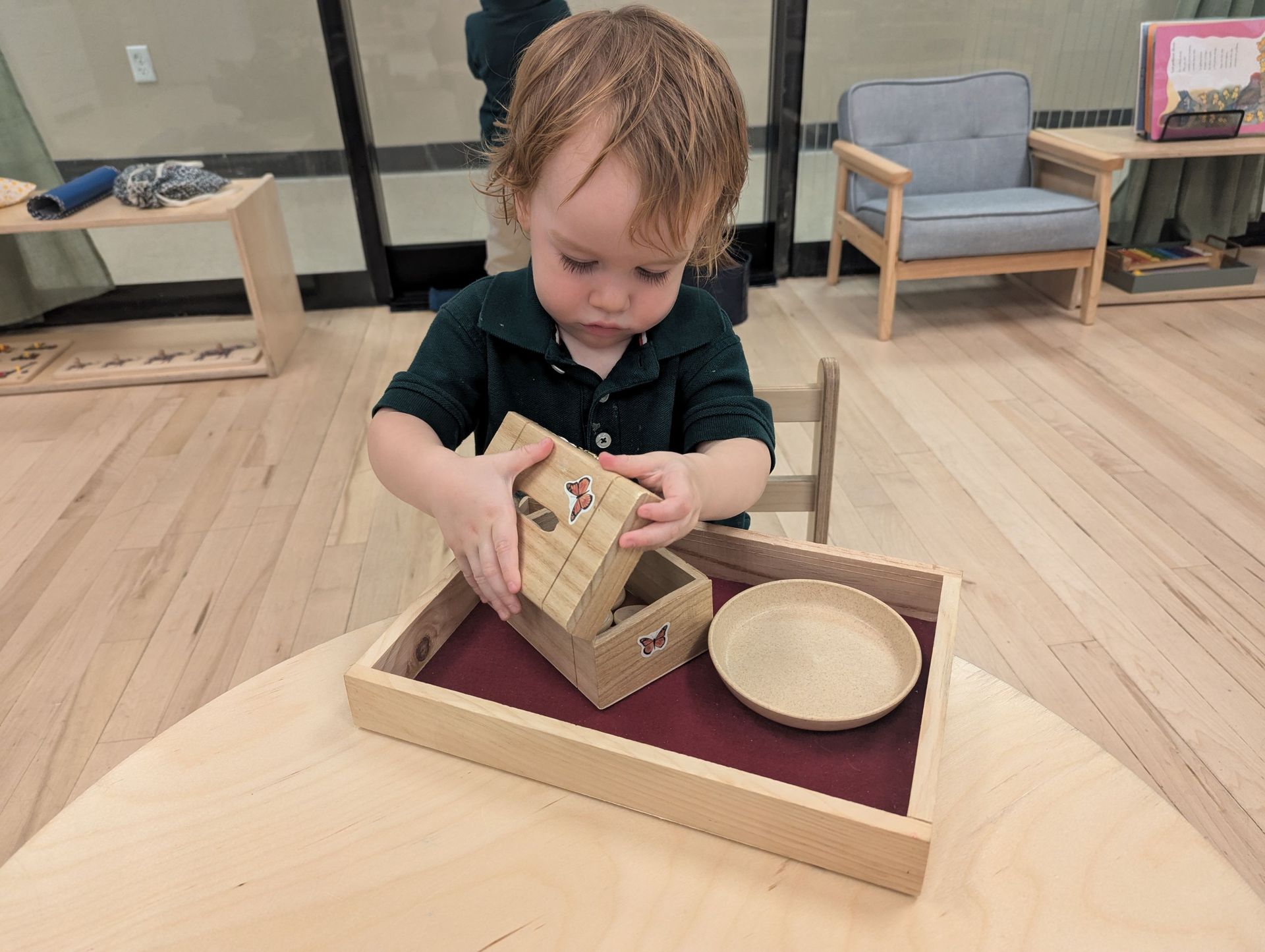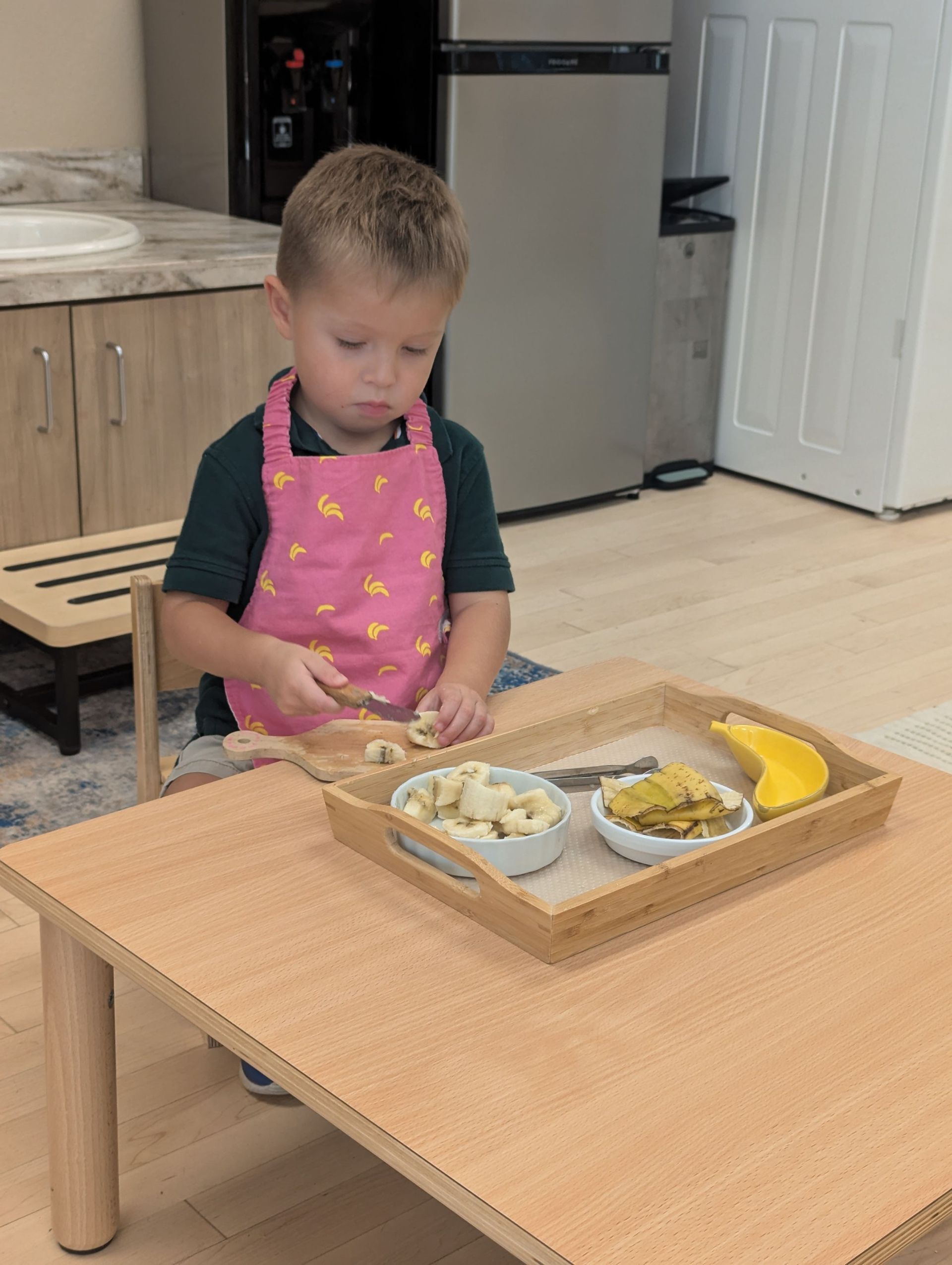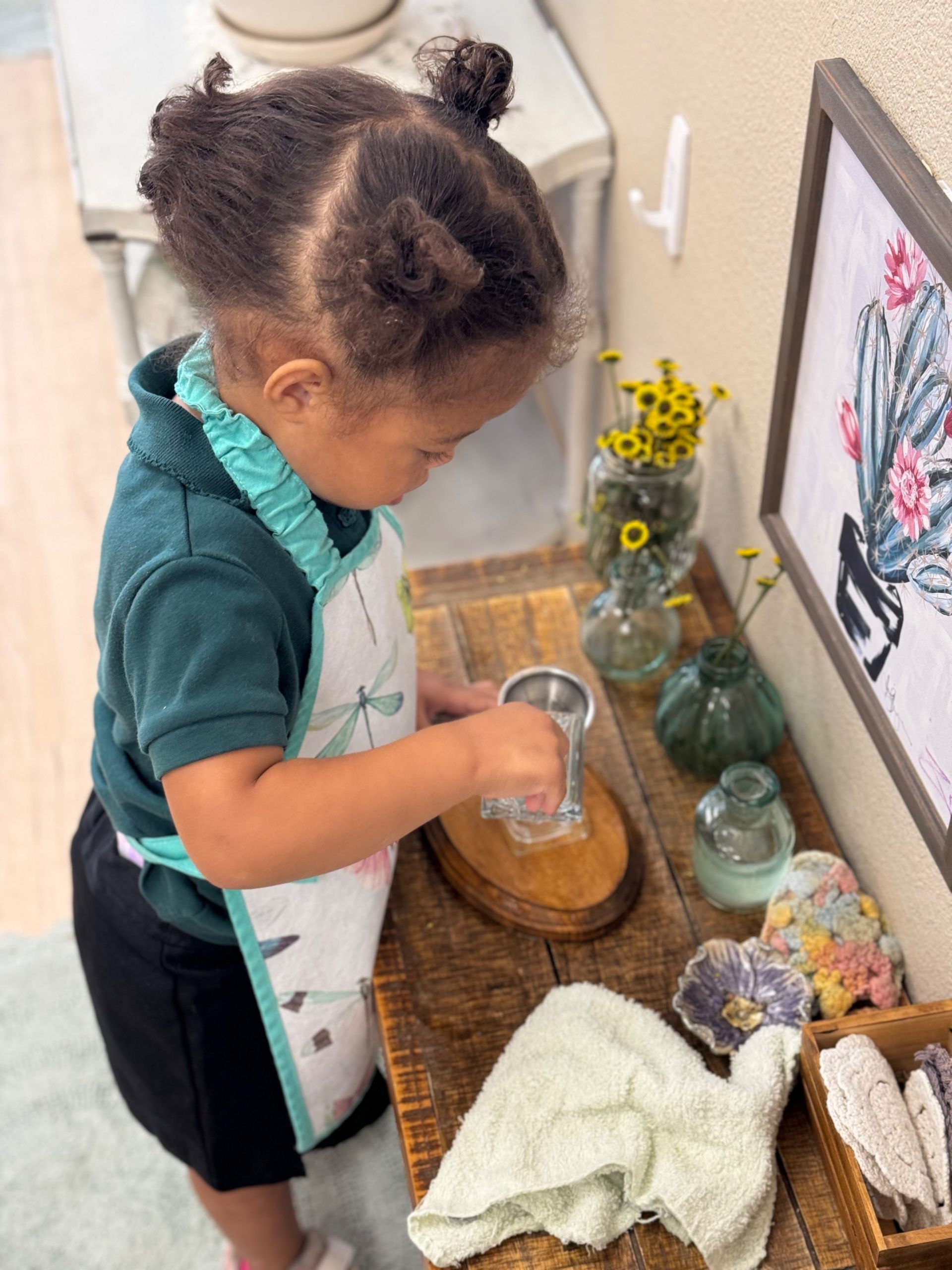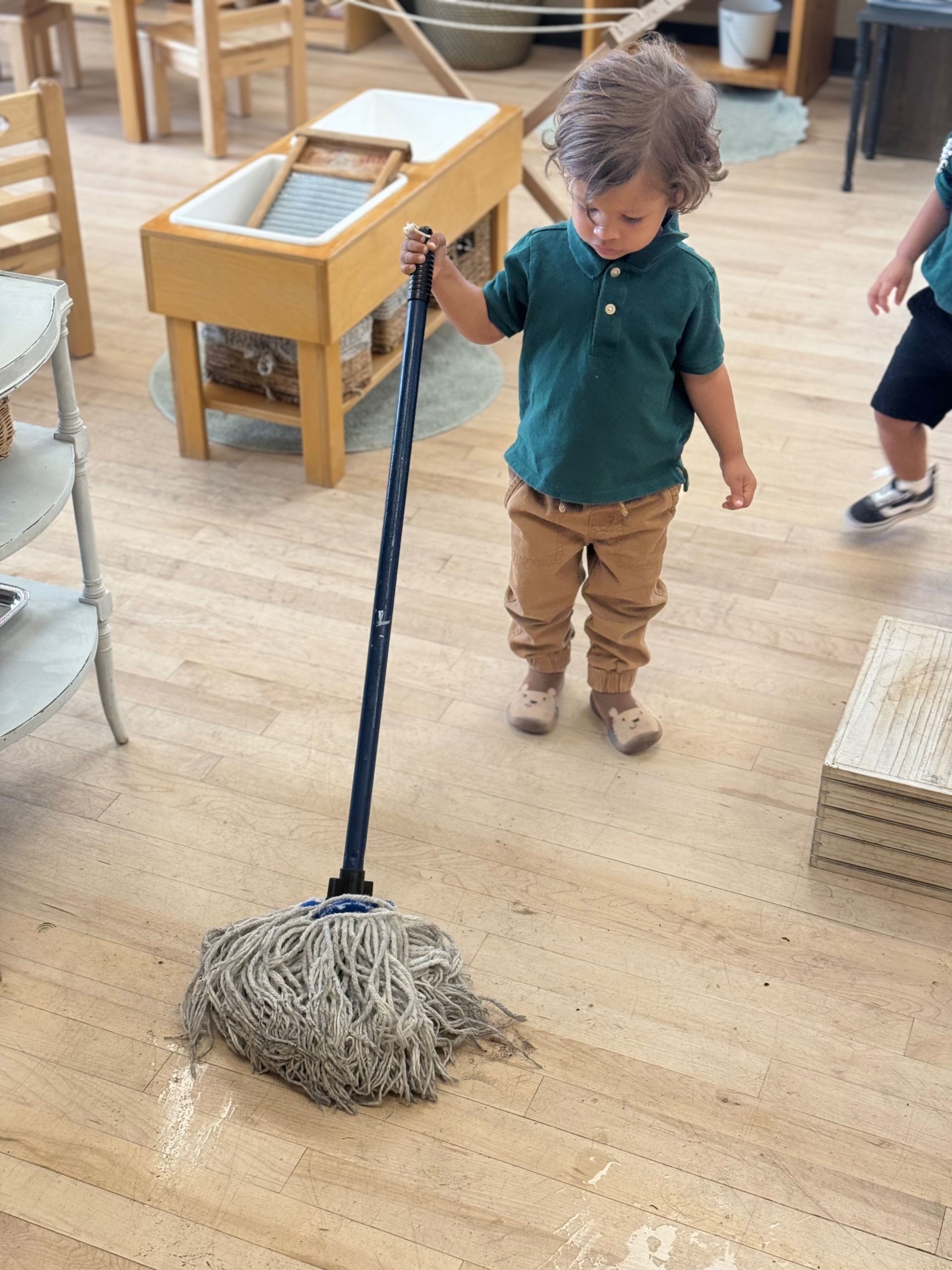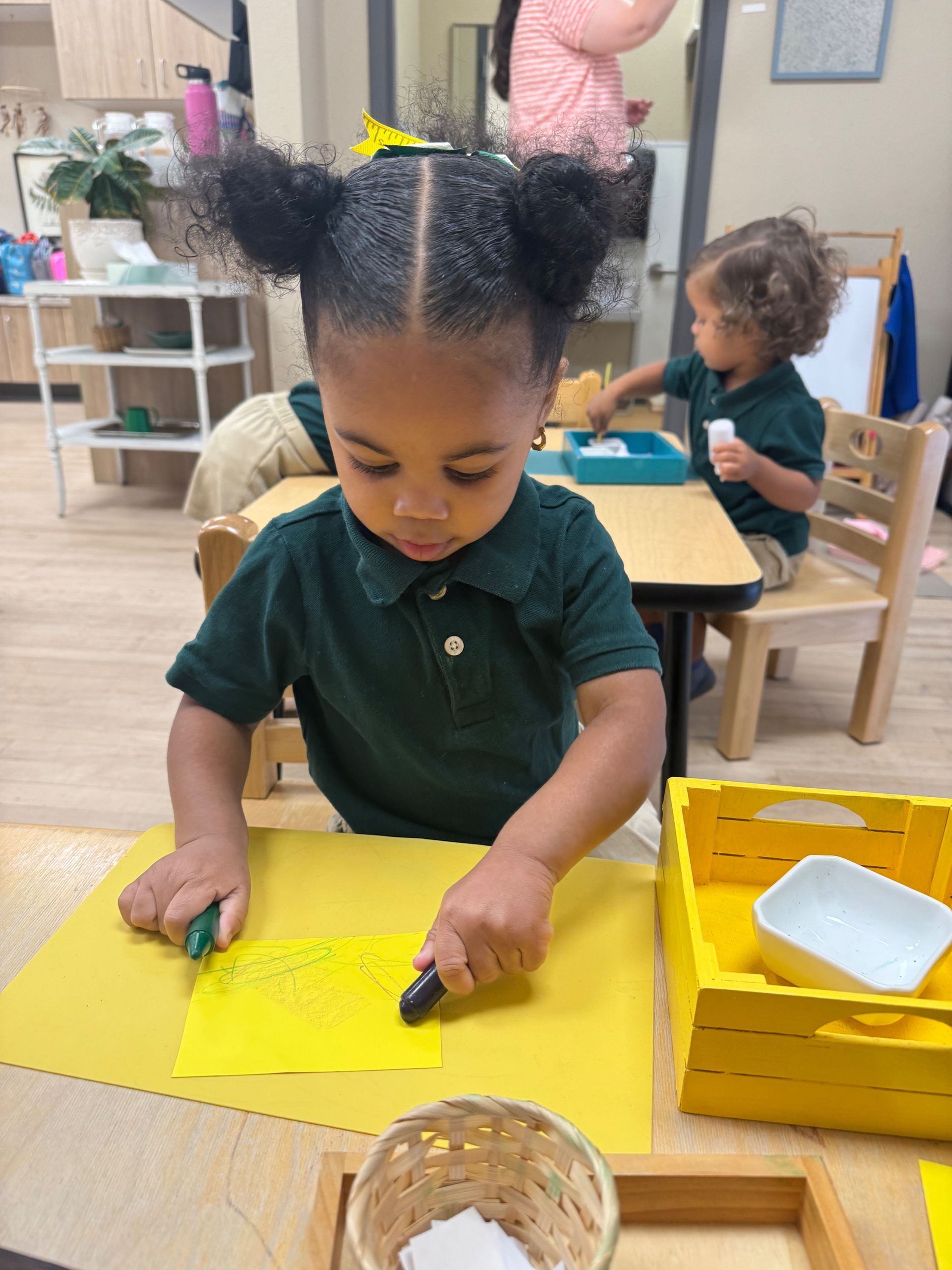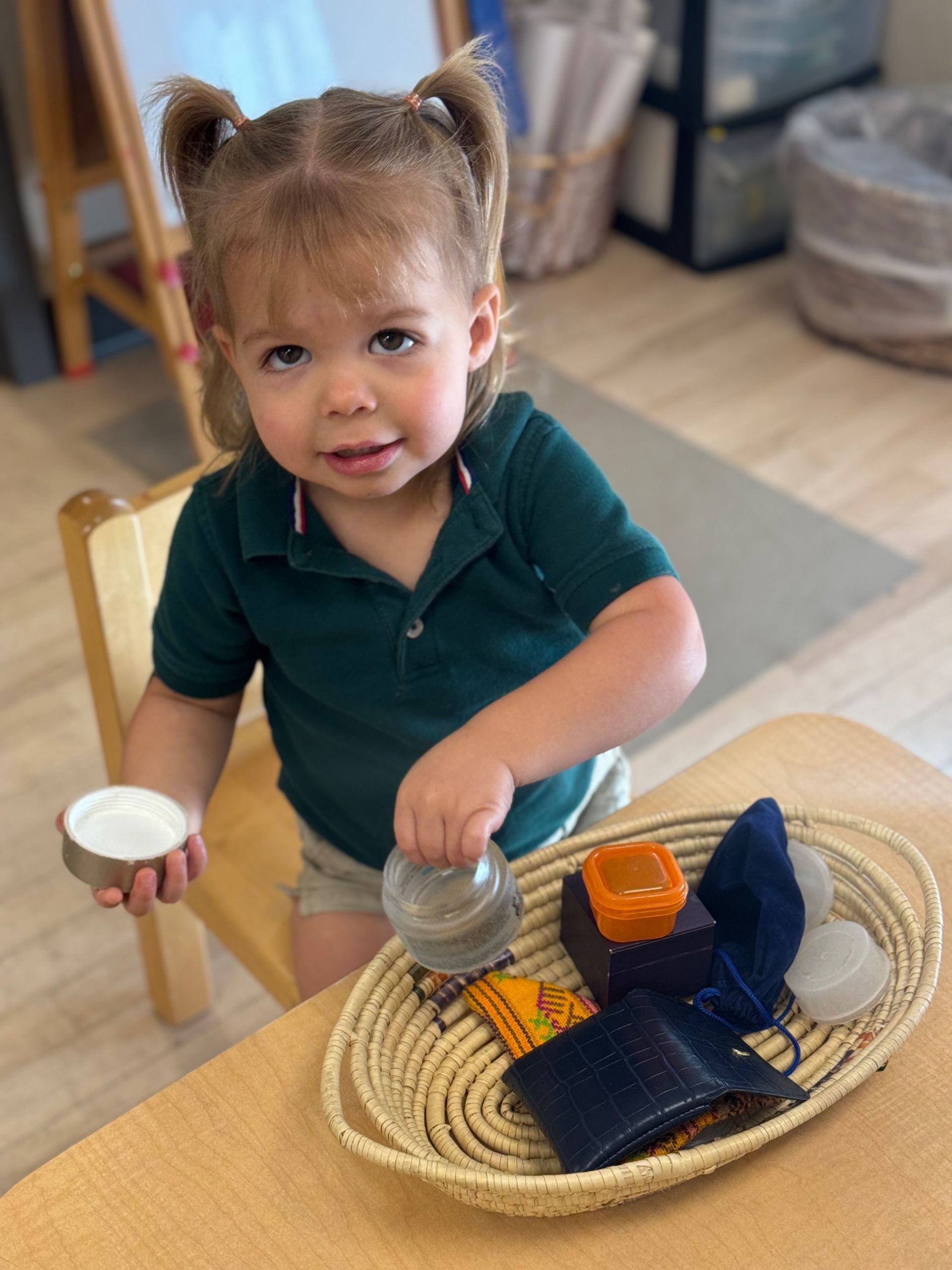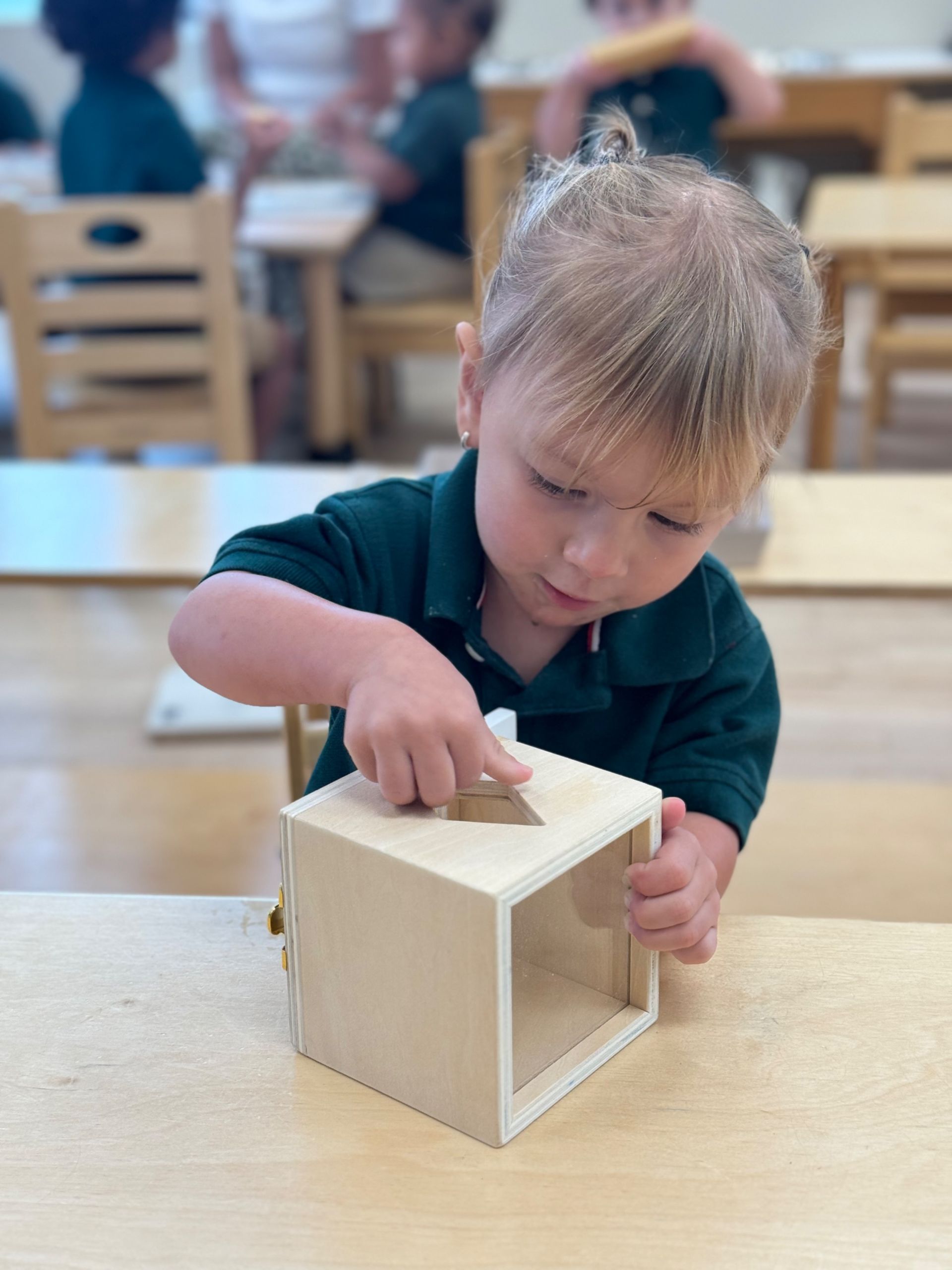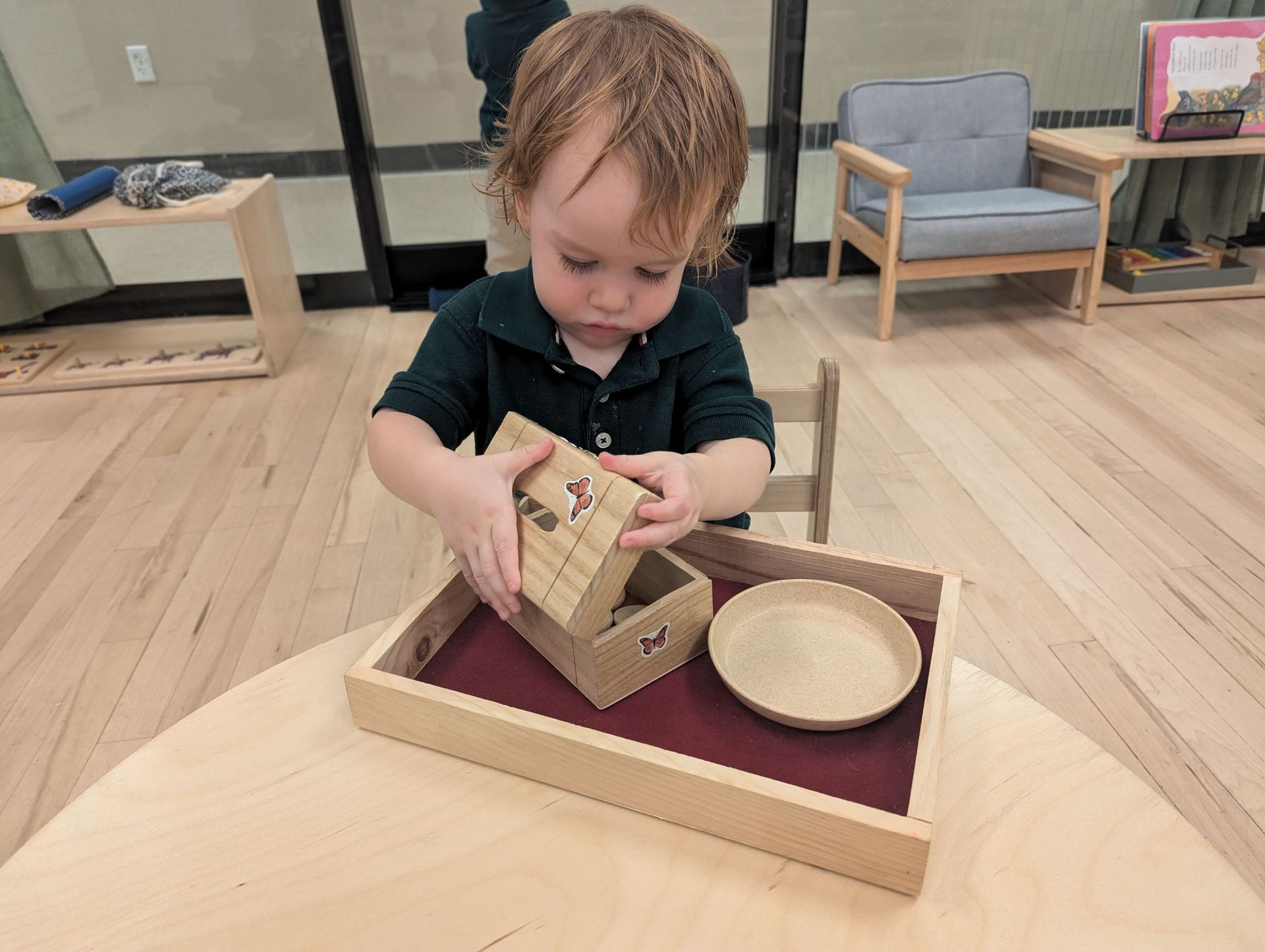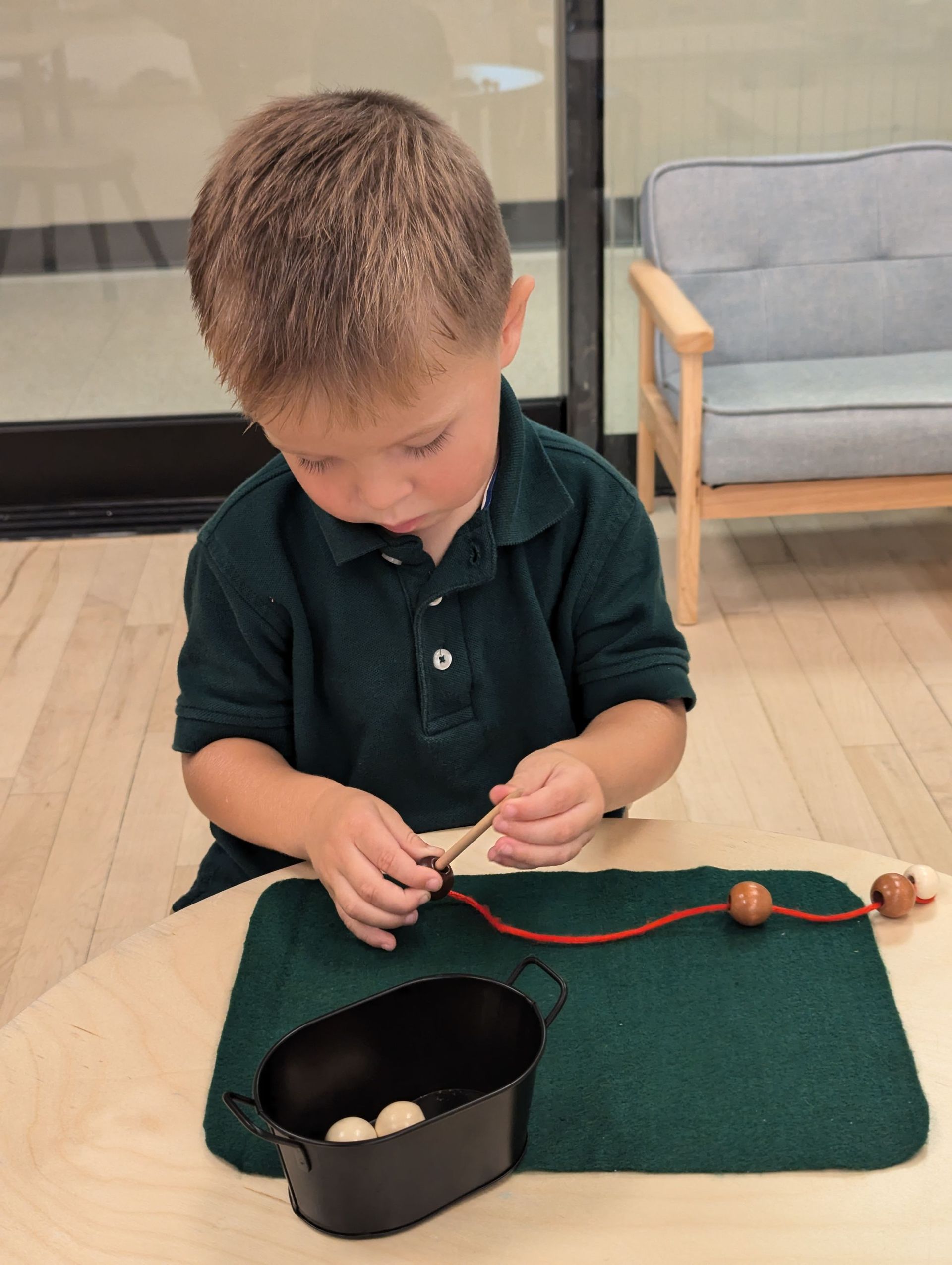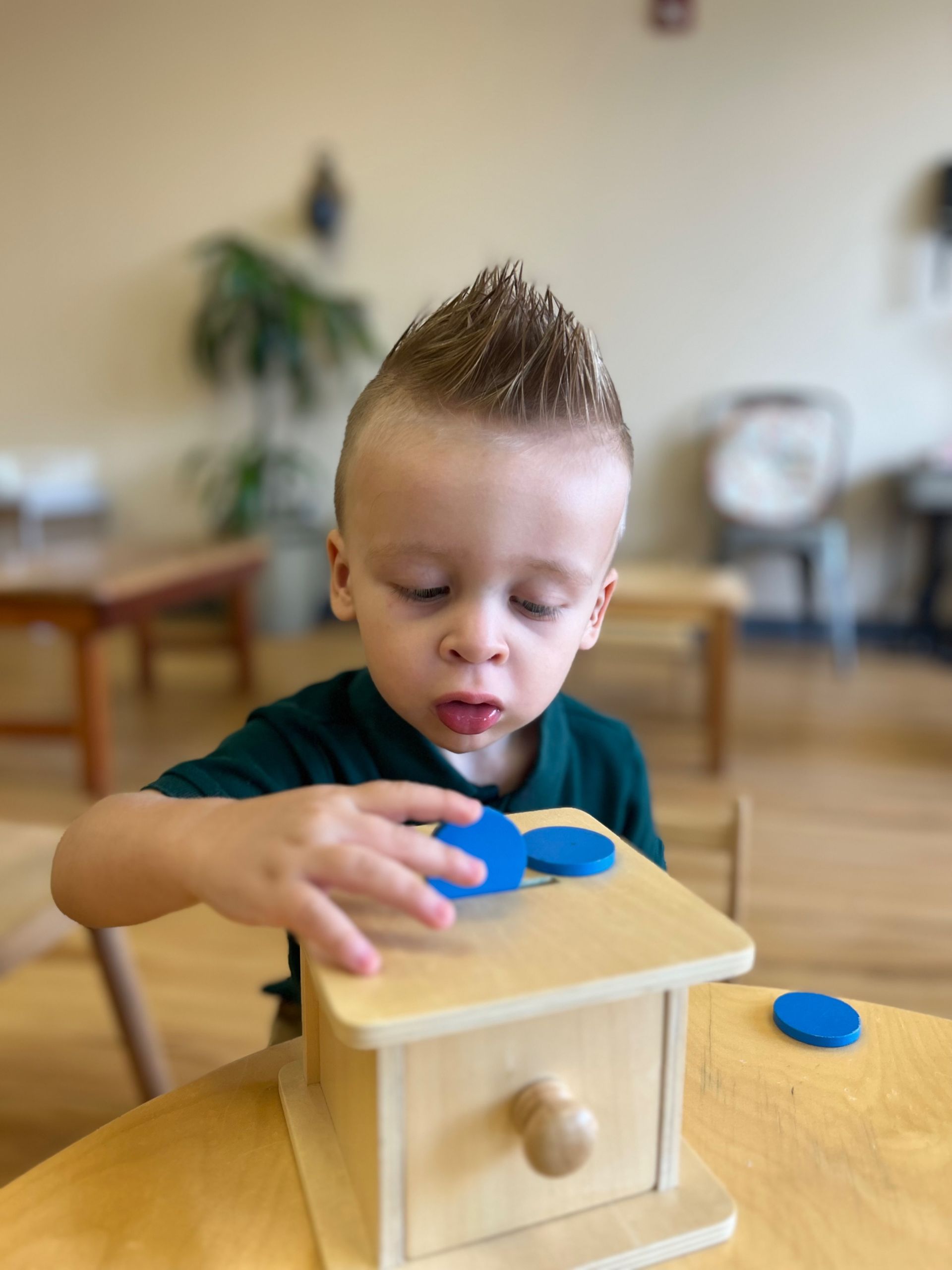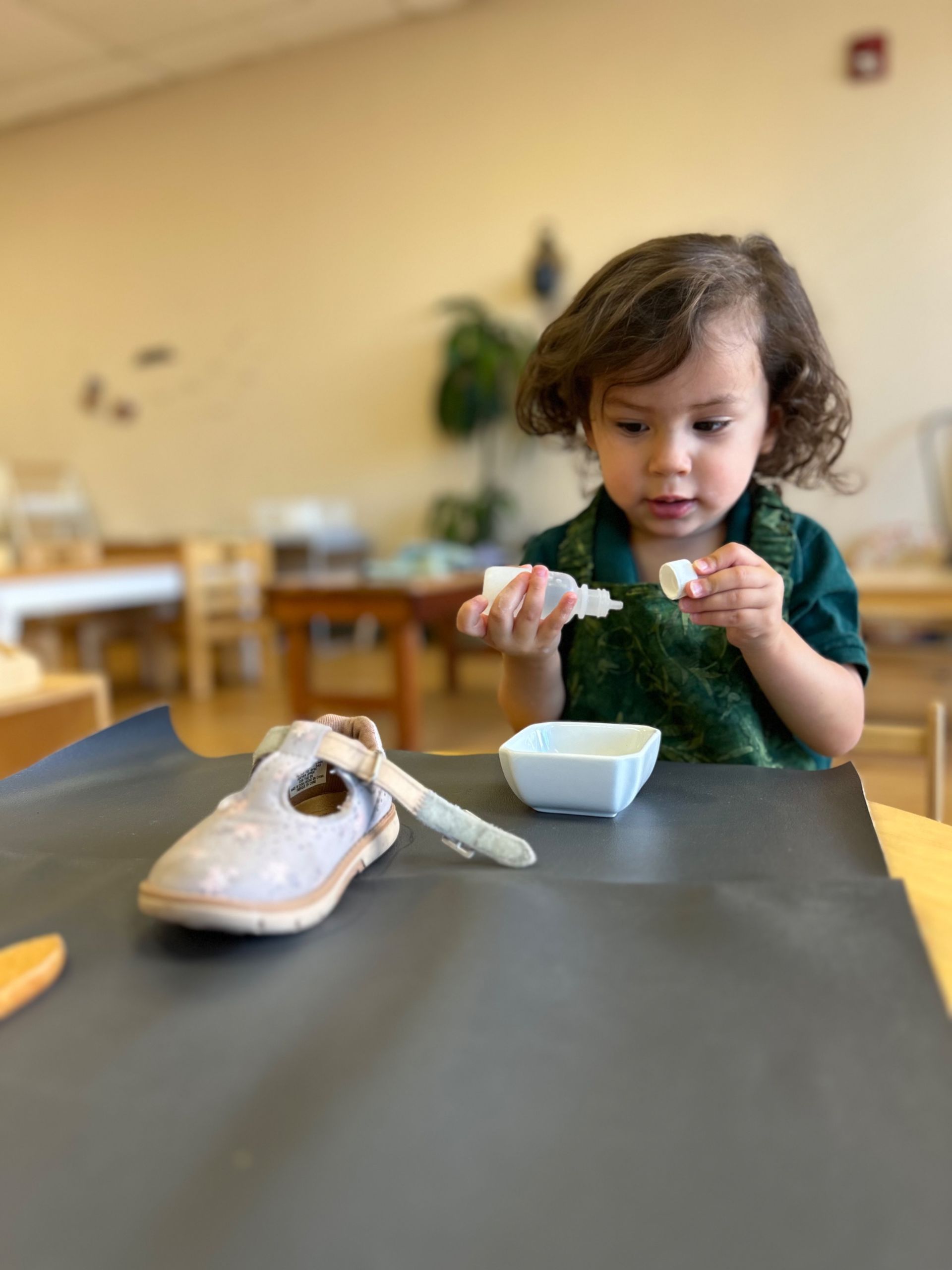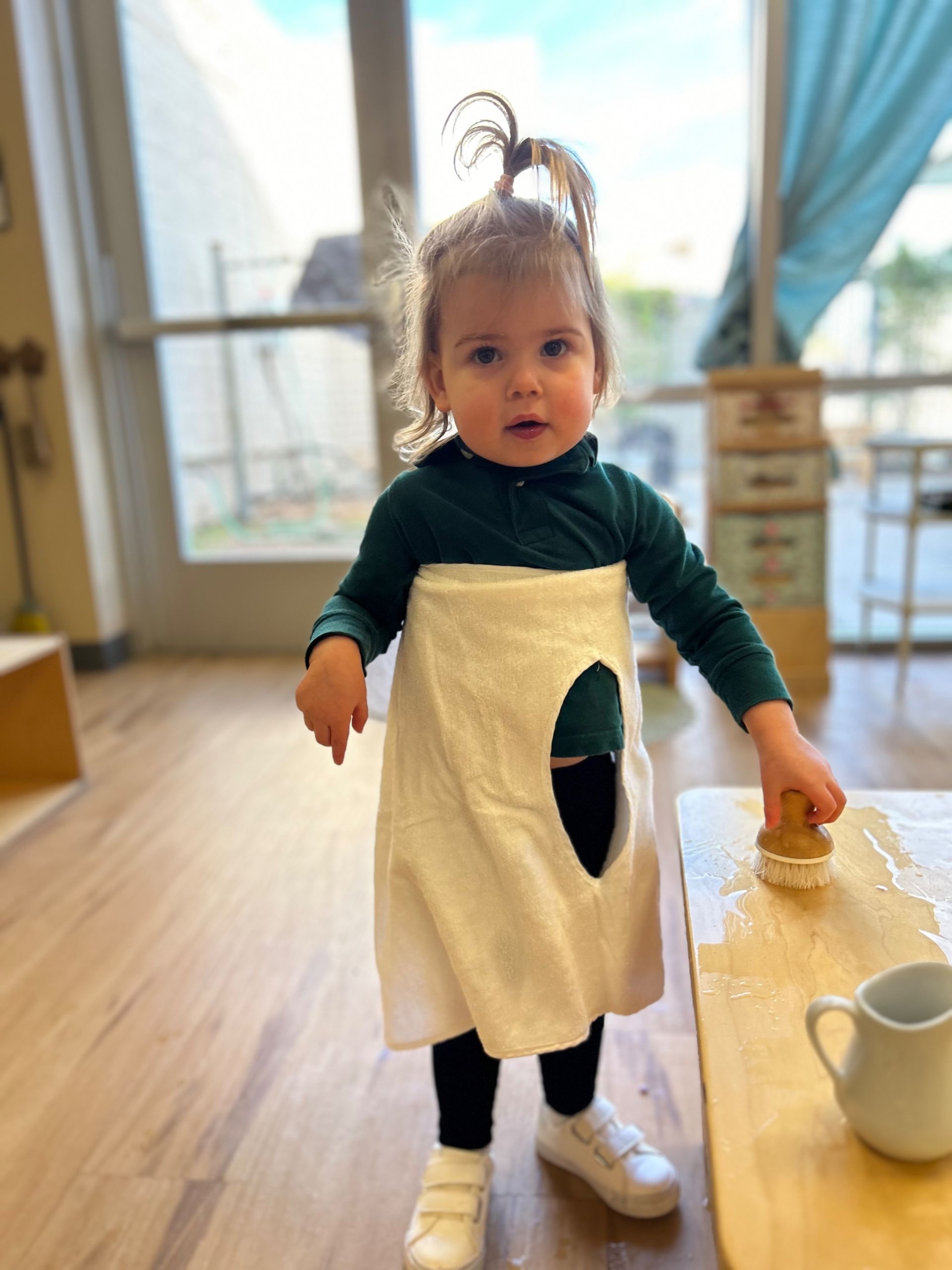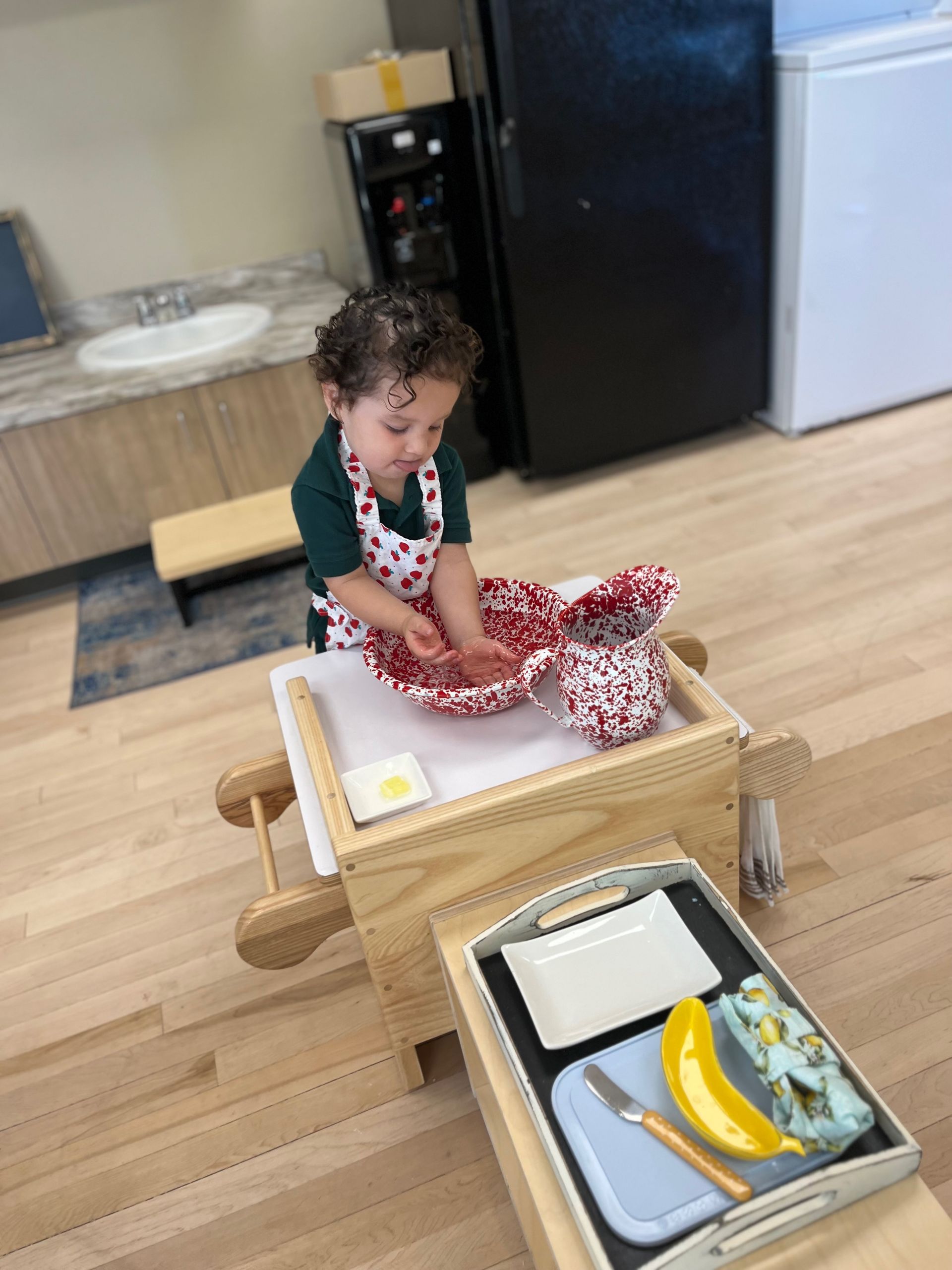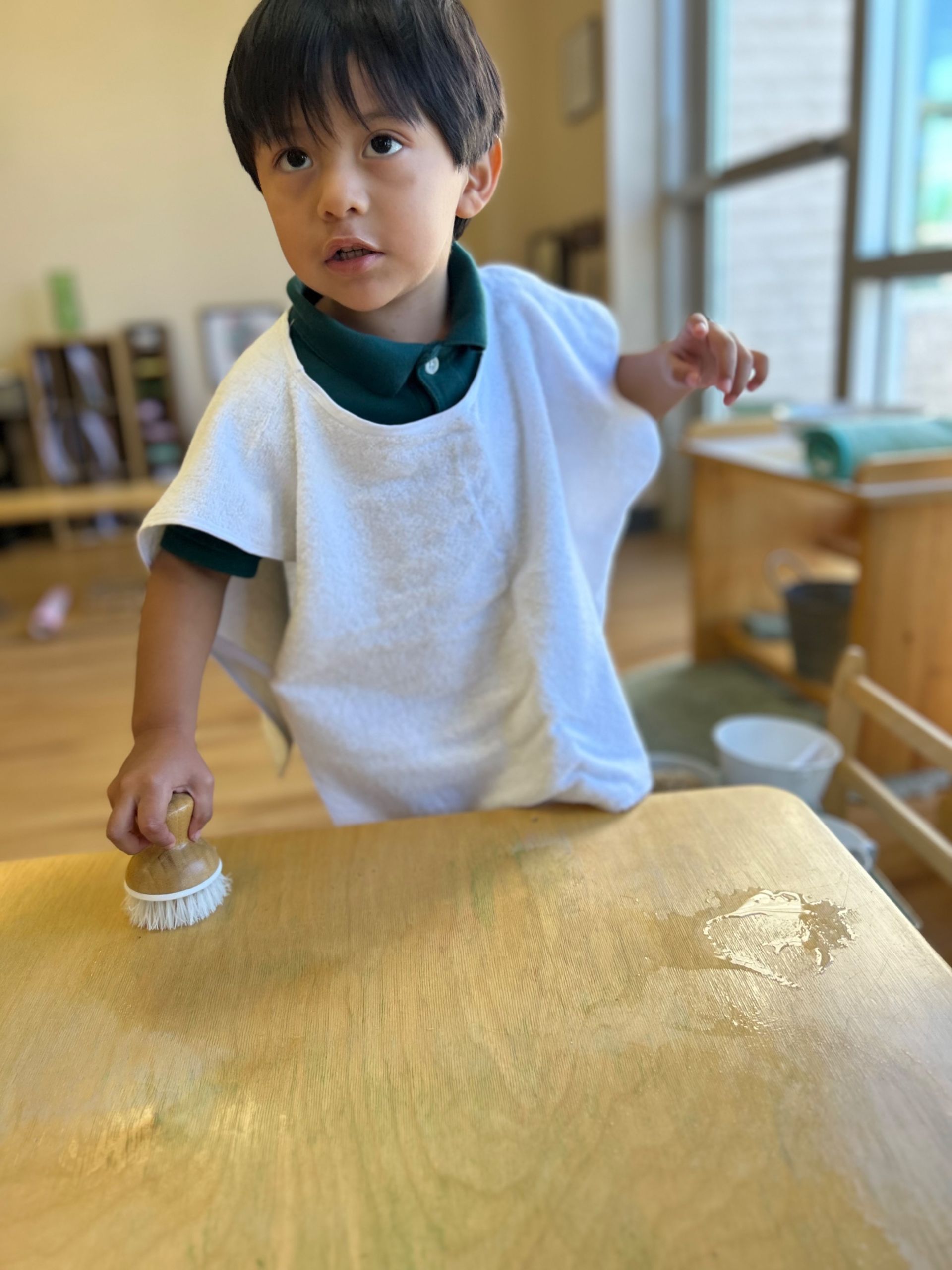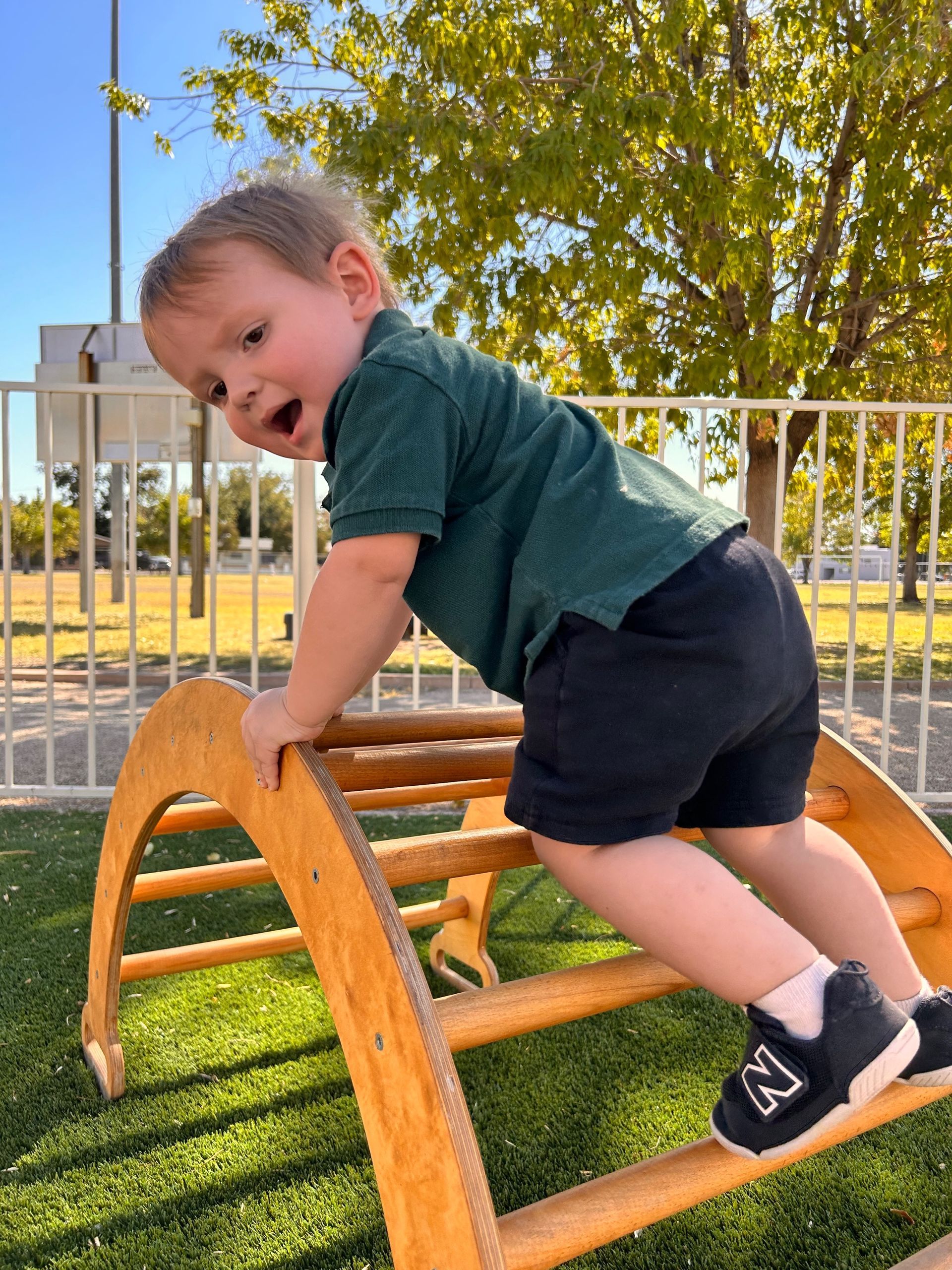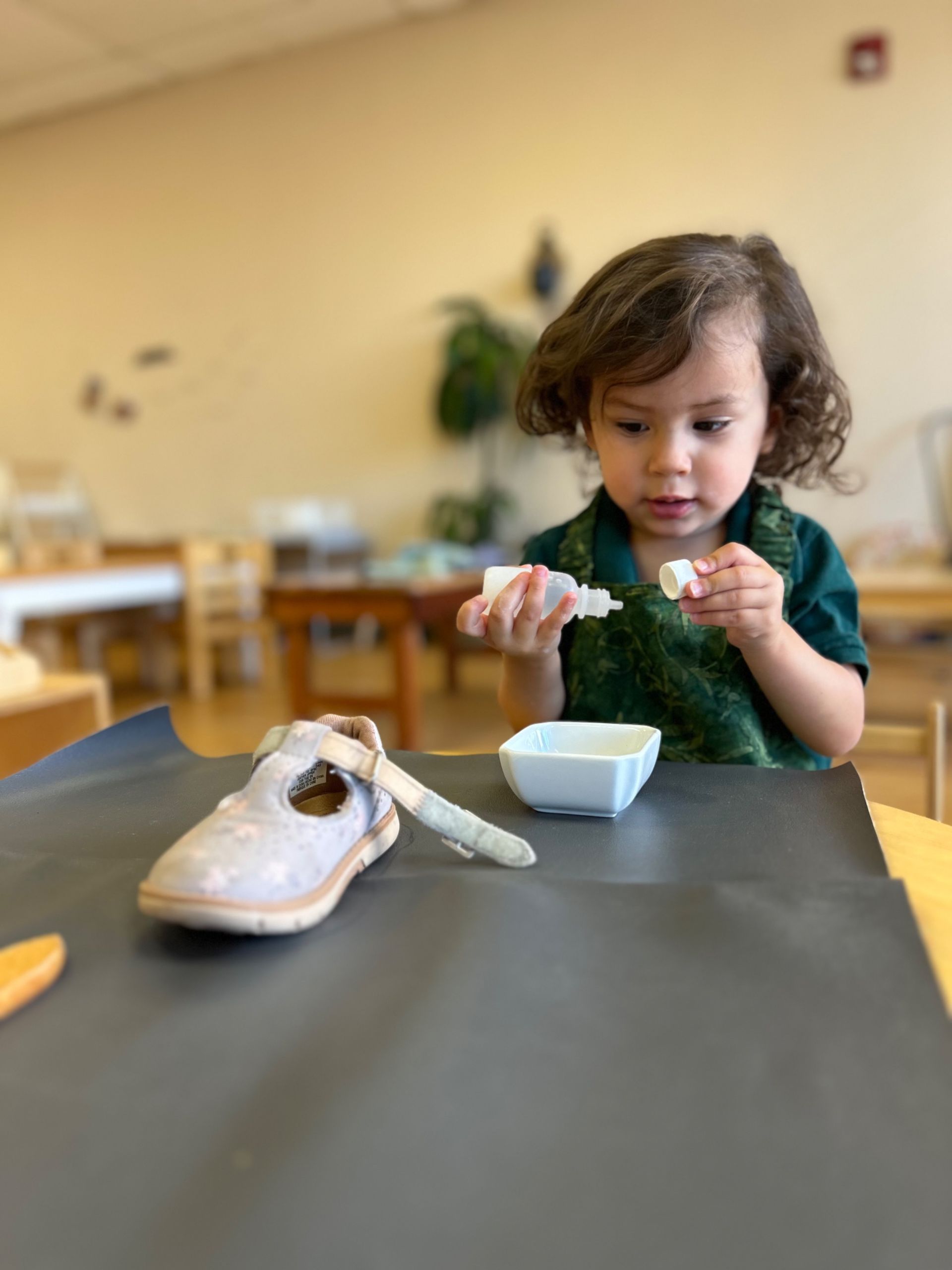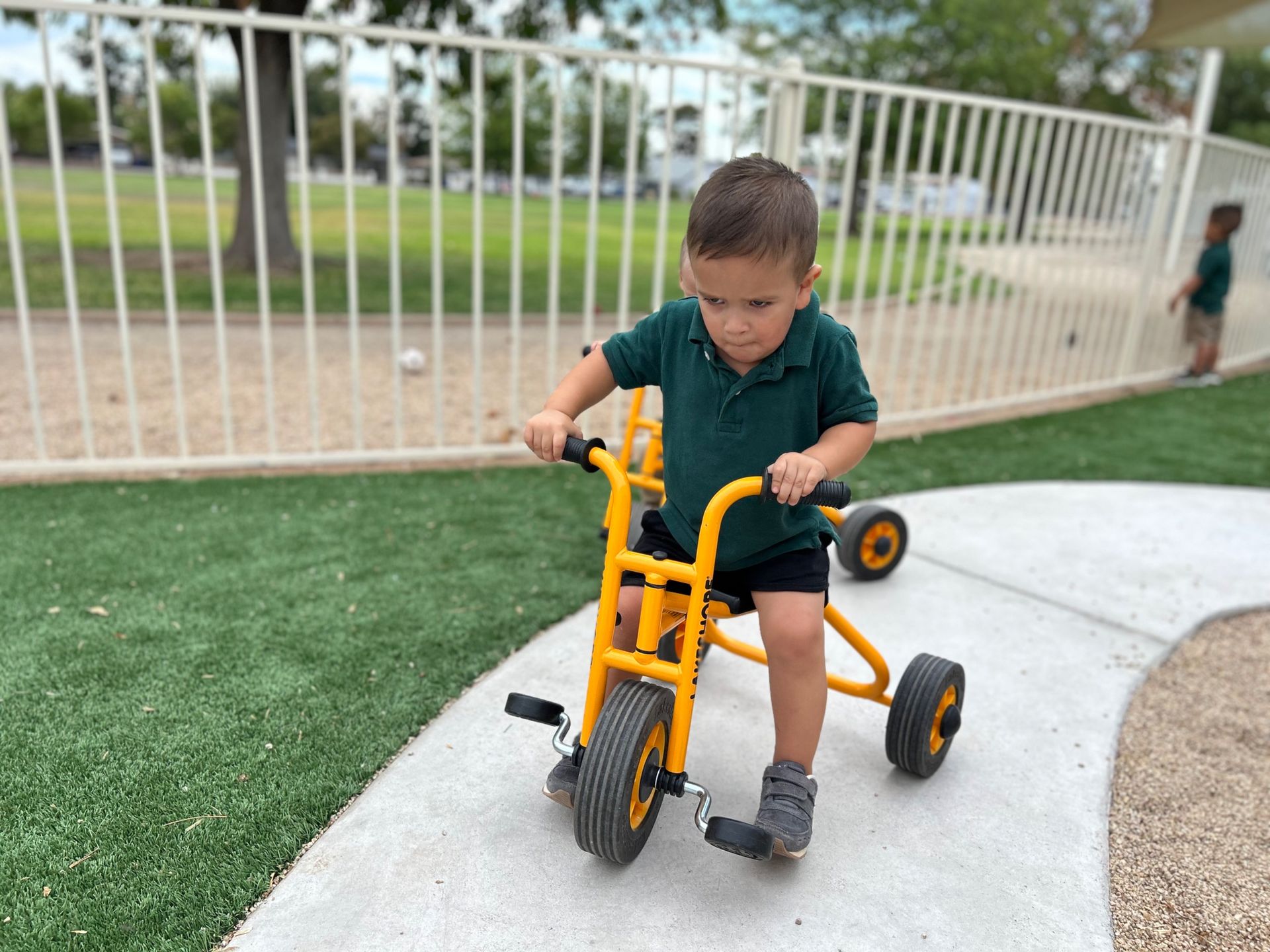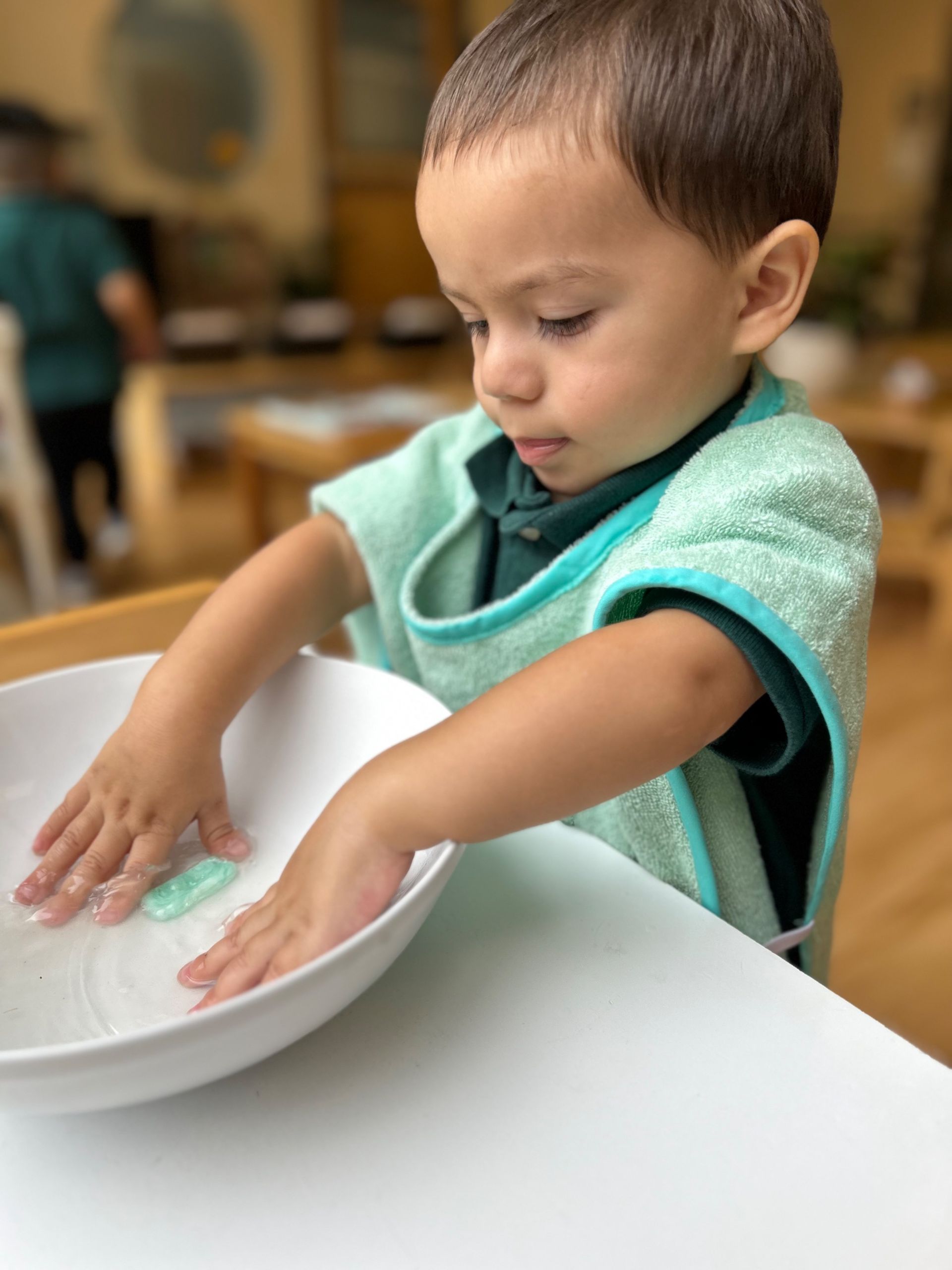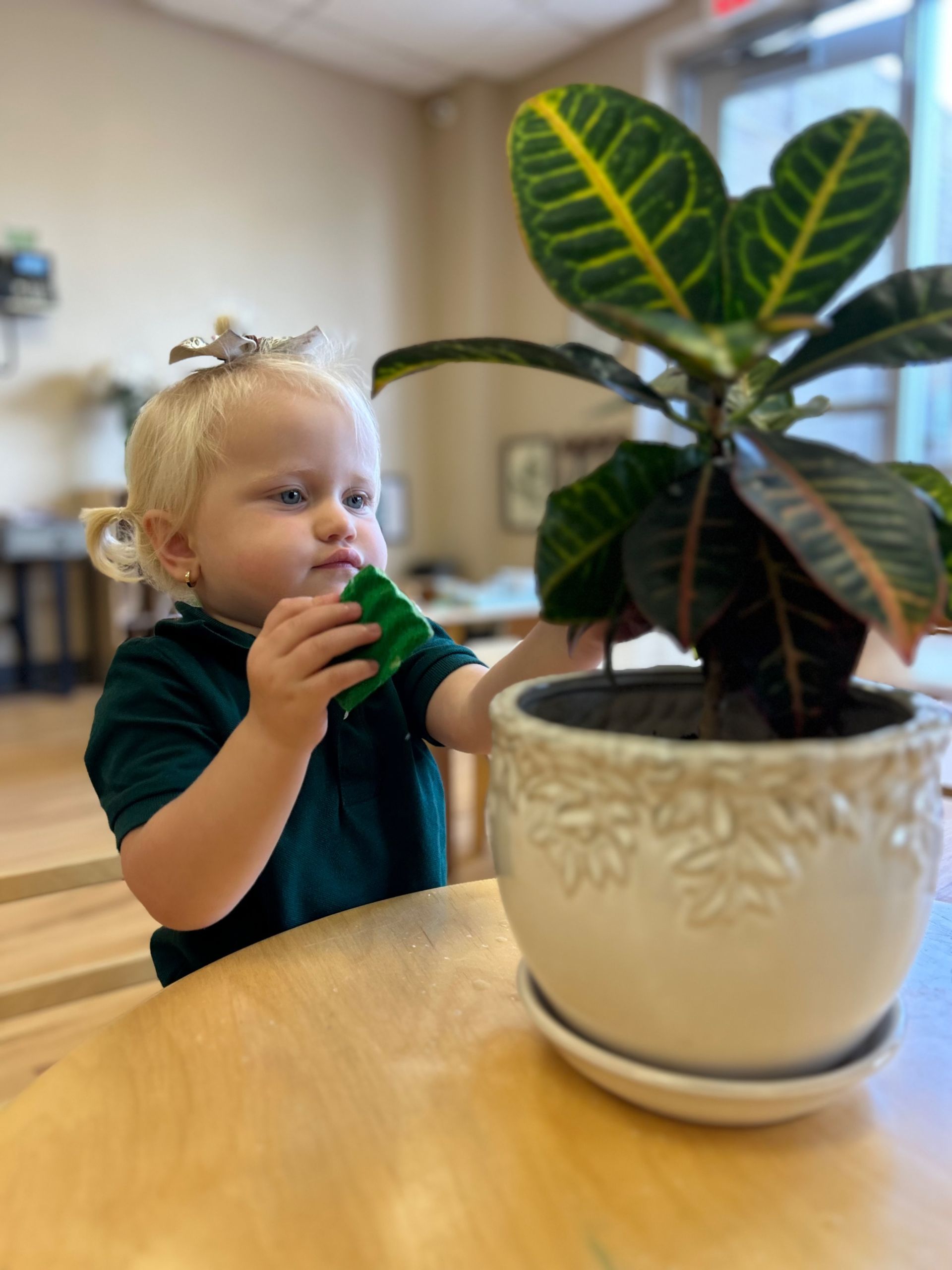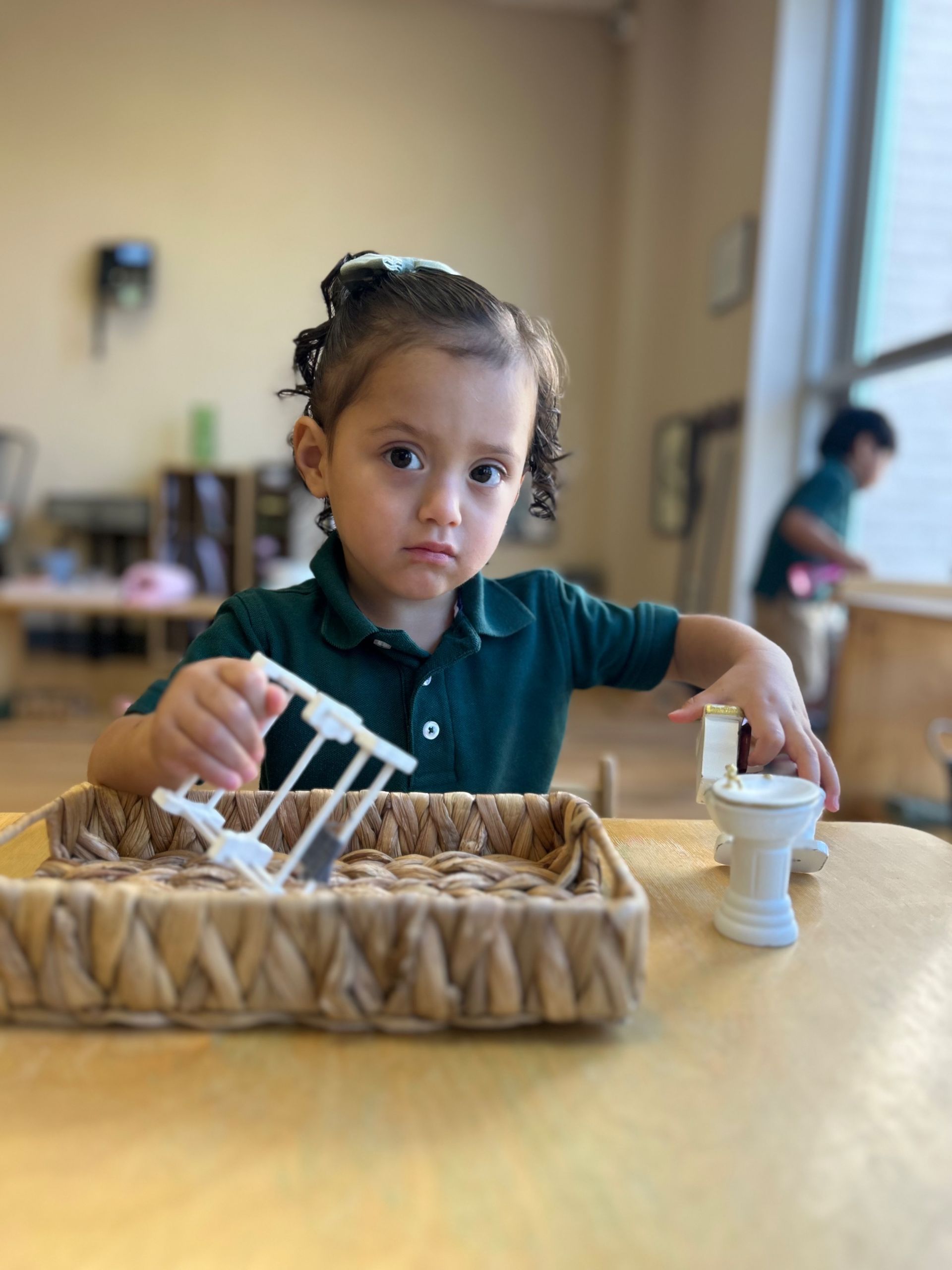TODDLER ARTICLES
Published: August 2025
Supporting Toddlers Through Life’s Adaptations
By: Lisa Hawkins, AMI Toddler Montessori Teacher
For adults, life is full of transitions like new jobs, new homes, changes in routine. We have learned how to adapt, even if it still takes effort. For toddlers, however, change can feel enormous. Whether it’s starting a new school year, entering a new classroom, meeting a new teacher, meeting new people, adjusting to a new sibling, visiting unfamiliar places, or navigating a shift in family routines, toddlers experience each change with fresh eyes and raw emotion. They have not yet built the confidence or trust that helps older children and adults adapt more easily. As an AMI-trained Montessori teacher with 20 years of experience, I have seen that adaptation is a gradual process and one that requires patience, empathy, and consistency from the adults who care for them.
Understanding Adaptation in Toddlers
Adaptation is the process of becoming comfortable and confident in a new environment or situation. For toddlers, this does not just happen at school, it happens in every aspect of life:
· At school: New classrooms, teachers, routines, or classmates.
· At home: A new sibling, a move, or changes in family schedules.
· In the community: Visiting a new park, going to the grocery store, or participating in activities with unfamiliar people.
Unlike adults, toddlers cannot yet reason their way through change. They rely on repetition, consistency, and the gentle guidance of trusted adults to feel safe enough to explore and engage.
Building Trust and Confidence
Before a toddler can truly adapt, they must first feel secure. This means building trust with the people in their environment and confidence in their own abilities. In Montessori environments, we do this through:
· Consistency: Keeping routines predictable so children know what comes next.
· Respect: Speaking to them calmly, listening to their needs, and honoring their emotions.
· Opportunities for independence: Letting them try tasks on their own, such as putting on shoes or pouring water, this helps them feel capable and in control.
At home and in the community, the same principles apply. A trip to a new library branch or playground becomes easier when we prepare the child with simple explanations, keep some routines the same (like snack time), and give them time to observe before jumping in.
Why Transitions Are Hard for Toddlers
For adults, small changes might feel like bumps in the road. For toddlers, even a small change can feel like a mountain. They thrive on repetition and predictability because these give them a sense of order in what can feel like a big, unpredictable world. Sudden changes, like a different drop-off person in the morning or new person taking them out of the car or a rearranged living room, can feel unsettling.
They also live very much “in the now.” They do not yet understand the concept of “later” or “tomorrow,” so they cannot easily see that discomfort will pass. This is why patience is key.
Supporting Toddlers Through Adaptation
Here are ways we can support toddlers as they face both big and small transitions:
1.
Maintain Familiar Routines
Keep as much of the child’s daily rhythm the same as possible, especially during times of change. If bedtime, snack time, or morning greetings remain consistent, they will feel more secure.
2.
Prepare Them for Change
Use clear, simple language to let toddlers know what will happen next. For example: “After we eat breakfast, we are going to your new classroom.” This helps them anticipate and mentally prepare.
3.
Give Time and Space
Rushing a toddler through a new situation often increases anxiety. Give them time to observe, approach, and explore at their own pace.
4.
Offer Independence
Whether at school, home, or in the community, find ways for toddlers to participate, like carrying their own snack, helping push the grocery cart, or choosing which socks to wear. This fosters confidence and engagement.
5.
Model Calm and Confidence
Toddlers often mirror the emotions of trusted adults. When we approach change with calm reassurance, they learn that new situations can be safe and manageable.
6.
Validate Feelings
Change can bring big emotions. Rather than dismissing them (“You are fine”), acknowledge them (“I see you feel sad about leaving the playground”) and offer comfort.
Adaptation takes time, sometimes weeks or even months. As adults, our role is to offer steadiness while they find their footing. Whether they are entering a Montessori classroom for the first time, welcoming a new baby sibling, or getting used to visiting a new community space, we can help by being patient, consistent, and understanding.
When we respect their pace and provide a secure base from which they can explore, toddlers gain not only adaptation skills but also a lifelong sense of trust in the world around them. And that trust, built little by little, becomes the foundation for confidence, independence, and joy in all of life’s adventures.
Published: April, 2025
Building and Facilitating Trust and Respect with Toddlers
From a Montessori perspective, toddlers are not just young children—they are actively engaged in a process of absorbing knowledge, learning, and forming relationships. As caregivers and adults, our role in their development is crucial. One of the most important aspects of this role is to build a foundation of trust and respect between adults and toddlers. This foundation can guide them through their growth and shape their understanding of themselves, others, and the world. At the heart of this relationship are the principles of consistency, honesty, boundaries, and modeling respectful behavior.
The Absorbent Mind: Understanding How Toddlers Learn
Maria Montessori's concept of the "absorbent mind" highlights how young children, particularly toddlers, take in everything around them with an intensity and thoroughness that often goes unnoticed. Their ability to absorb information is profound—they observe, listen, and internalize everything in their environment, including how we communicate, set boundaries, and model behaviors. This means that toddlers are incredibly sensitive to the way adults interact with them. They do not just learn from what we say; they learn from how we say it, from our body language, our tone, and the consistency with which we follow through on our words.
This is why building trust and respect begins with adults being the best models they can be. If we want toddlers to respect us, we must respect them first. We must be mindful that their trust is something to be earned and maintained through our actions, consistency, and honesty.
Setting Limits and Boundaries
Setting limits and boundaries with toddlers is an essential part of fostering trust and respect. Boundaries create a sense of safety and security for children, helping them to understand where their behaviors are acceptable and where they are not. The key here is consistency. Toddlers thrive when they know what to expect, and this consistency helps them develop a sense of responsibility for their actions.
For example, if a toddler is not allowed to hit, then the adult must gently but firmly enforce this limit each time. It’s important to stay calm, clear, and consistent without raising your voice or showing frustration. By doing so, toddlers learn that their actions have consequences, and they come to understand the importance of respecting boundaries—not only because they will face consequences if they don’t, but because this respect for limits helps them navigate the world in a way that feels safe and predictable.
The Importance of Follow-Through
Follow-through is one of the most powerful tools for building trust. When an adult sets a limit or makes a statement to a toddler, it is imperative that they follow through. If an adult says "no," the toddler must experience the consequence of that "no" if they go past the boundary. Toddlers rely on consistency, and if adults do not follow through, the toddler will begin to feel uncertain about the rules and expectations set for them. This uncertainty can lead to confusion and even a breakdown of trust.
This is particularly important when it comes to everyday choices. If a toddler is asked to make a choice, such as deciding between a red or blue shirt, and they choose red, the adult must honor that choice. If the adult then says, “Well, I wanted you to wear blue,” the toddler’s trust is undermined. They might start to feel that their preferences are not valued or respected, and this can affect their sense of autonomy and self-worth.
It’s essential that when we offer choices, we are prepared to honor them. If we can’t, then it’s best not to offer them in the first place. Giving toddlers a genuine say in certain aspects of their day—whether it’s what shirt they wear, what snack they want, or what activity they engage in—empowers them and fosters a sense of respect. When adults follow through on their commitments, toddlers learn that their choices matter, and they start to trust that what is said will be respected.
Avoiding Shaming, Belittling, or Yelling
One of the most damaging things an adult can do in the process of building trust and respect with a toddler is to engage in shaming, belittling, or yelling. These behaviors not only cause harm to the child’s emotional well-being, but they also send a message that the adult is not in control of their own emotions or behavior. If adults resort to yelling or shaming, toddlers may begin to replicate this behavior, as they learn by example. Instead of fostering respect, such actions create fear and resentment, breaking down the trust that is necessary for healthy development.
In Montessori education, the focus is on respectful communication and conflict resolution. Toddlers should be guided with gentle firmness, always keeping their dignity intact. This helps build a positive relationship where the child feels respected and valued, leading to healthier emotional development and stronger trust in adults.
Honesty with Toddlers
Toddlers are more perceptive than we sometimes give them credit for. They understand much more than we realize, including when we are not being honest with them. If an adult tells a toddler something that isn’t true or makes promises that cannot be kept, it undermines the relationship of trust. For instance, if an adult says, "We’ll go to the park in a few minutes," but doesn’t follow through, the toddler will quickly learn that the adult’s words do not hold weight. This teaches them to distrust the adult and can make it harder to establish a foundation of respect.
It’s crucial to be truthful with toddlers, even when the truth may be difficult or uncomfortable. For example, if a change of plans is necessary, explaining it honestly—rather than making up an excuse—shows the child that they can rely on the adult for truthful information. This not only supports their emotional development but also teaches them to value honesty in their own interactions with others.
The Power of Respectful Modeling
In the Montessori approach, adults are seen as "guides" rather than authoritarian figures. It’s our responsibility to model the behaviors we wish to see in children. Toddlers are constantly observing and absorbing everything around them, so it’s vital to model respectful language, emotional regulation, and appropriate social behaviors. This is how toddlers learn to build their own sense of self-respect and respect for others.
When an adult models calmness, patience, and respect, toddlers will often begin to mirror these behaviors. They learn how to express themselves respectfully, how to regulate their emotions, and how to interact with others in ways that promote healthy relationships. This modeling is one of the most powerful tools for instilling values of trust and respect.
Conclusion
Building trust and respect with toddlers is essential for fostering a healthy, supportive relationship. This can only be done through setting clear boundaries, following through with consistency, and being honest and respectful in every interaction. By embodying the qualities of respect, patience, and reliability, adults can guide toddlers to not only trust and respect them but also learn to extend the same qualities to others. The toddler years are a time of intense growth and learning, and by nurturing these qualities, we help lay the foundation for a confident, capable, and respectful young person.
By: Lisa Hawkins
Published: January 2025
Growing Together: Supporting Social and Emotional Development in Toddlers
Toddlers need an environment that allows them to express emotions and develop healthy social relationships. These experiences help our toddlers develop empathy, emotional regulation, and resilience, which promotes mental well-being. Beginning early will pave the path for future academic success and positive lifelong outcomes.
Social and Emotional Development begins at birth, with newborns capable of experiencing and expressing emotions through crying. As they grow, they develop the ability to communicate and regulate their emotional responses. To truly grasp this development, it's essential to differentiate between 'emotions,' 'feelings,' and 'mood.'
- Emotions are a brief result of external stimuli accompanied by universal body expressions.
- Feelings are how we interpret emotions and let them sink in. They are influenced by past experiences.
- Moods are influenced by the environment, diet, and physical health. The mood is how we feel over time and is also influenced by temperament. (Dakota Family Services)
As adults, it is crucial to have a clear understanding of these definitions and how they work together creating a cycle of social and emotional development. This knowledge empowers us to identify our toddler's mood or needs and provide an accurate stimulus.
Toddlers progress through various 'milestones' of social and emotional development. These milestones represent the fundamental skills and abilities toddlers need to develop early on. Some milestones that we can easily identify and support in our daily interactions are:
Self-awareness
Toddlers are learning who they are physically and psychologically. Babies first develop physical self-awareness by exploring and recognizing their own bodies. Observe how babies are fascinated while playing with their hands or feet. Babies then start rolling on their tummies, giving them a different perspective of their world and body in their environment.
As they gain more physical abilities, they acquire more experience and understanding of their physical bodies. Toddlers are now walking, which frees their hands. They feel more empowered and realize that they are their own person.
How to support the development of self-awareness at home:
- Provide responsive care during daily interactions such as changing diapers, bathing, or dressing while narrating the actions positively and naming the parts of the body.
- Use your child's name frequently. You can create a photo album and show it to your child, narrating the actions and using the child's name while doing so.
- Include your child in family meals and have conversations; though your child might not be verbal yet, these interactions help your child feel included as a participating family member, developing a sense of belonging.
Self-Regulation
Self-regulation is a slow and complex process involving the coordination of the body and mind. Babies are not born with self-regulation; they will learn how to regulate based on their experiences in the environment and their caregivers' interactions. How we respond to the child's needs creates the foundation for self-regulation.
Attachment plays a principal role in this aspect; the baby's attachment to the primary caregiver (mother/father) sets the foundation for how the toddler will react to the environment's stimuli.
How to support self-regulation at home?
- Create routines: According to Dr. Maria Montessori, children have a human tendency to order, which helps them make sense of the environment and aids in adaptation. A child with order in the physical environment and established routines will feel safe. Create a routine that works for your family, including your toddler, in activities where they can collaborate.
- Remove items that you do not wish your toddler to touch or play with from your toddler's reach. If your toddler reaches an object you do not want him to play with, gently redirect and offer an alternative. Setting limits is important from toddlerhood!
- Share self-soothing techniques with your toddler in moments of emotional burst. Model how to breathe, and you can use simple phrases such as "smell cookies, blow bubbles" to help them calm down.
Social Understanding and Relationship with peers
Social understanding is the ability to interact with other peers and caregivers. Dr. Montessori described "gregariousness" as a human tendency, meaning that we all have a need to socialize and live in a community. Toddlers exposed to early socialization will build a strong foundation of trust in their environment and form healthy relationships.
How to support Social Understanding at home?
- Include your child in family routines and events, and provide opportunities for playdates or park visits.
- Involve your toddler in pet care; though these are not human interactions, they help your baby develop empathy and respect for animals and nature.
- Read books, dance, and sing together.
We encourage you to practice these strategies at home and always talk to your toddler. Language development is crucial for social and emotional development!
By: Lidia Thaler
Published: December 2024
Making Holiday Memories with Toddlers
The holiday season is a magical time of year, especially through the eyes of a toddler. As Montessori teachers, we understand that the best gifts we can give our children are experiences, time, and memories. This season offers a beautiful opportunity to focus on creativity, connection, and respect for a toddler’s unique needs and developmental stage.
The Art of Giving: Creativity from the Heart
Toddlers are naturally creative, and their artistic expressions are pure reflections of their individuality. During the holiday season, involving toddlers in creating gifts and decorations not only gives them a sense of pride but also instills in them the joy of giving.
A simple yet meaningful activity is turning your child’s artwork into cards or wrapping paper. Provide large sheets of paper, tempera paints, or crayons, and let your child explore their creativity freely. Resist the urge to guide them too much; instead, let them experiment with colors, shapes, and textures. Their unstructured art becomes a truly unique way to share holiday cheer.
Another option is to collaborate on handmade gifts. Frame a painting, create simple ornaments, or use handprints to make keepsakes. These gifts not only delight the recipients but also help toddlers understand the joy of giving something they’ve made themselves.
Balancing Festivities: Respecting a Toddler’s Needs
The holidays often come with bustling family gatherings and long social events. While these occasions are joyful, they can also be overwhelming for toddlers. It’s important to respect their limits and provide opportunities for rest and quiet time during busy days.
Montessori philosophy emphasizes the importance of fostering independence and self-awareness, which includes allowing toddlers to set boundaries. During family functions, this means not forcing them to hug relatives or interact beyond their comfort level. Instead, encourage alternative forms of greetings, such as a wave or a high-five. Respecting their autonomy teaches them that their feelings and boundaries matter, which is a gift that will serve them for a lifetime.
Focusing on Memories, Not Materialism
In our Montessori classrooms, we emphasize the joy of experiences over material possessions. This principle is especially meaningful during the holiday season. Rather than centering celebrations around gifts, focus on creating special moments that toddlers will carry with them.
Bake cookies together, take a nature walk to collect pinecones, or sing holiday songs as a family. These simple activities provide sensory experiences and opportunities for connection. Toddlers thrive on routine, so incorporating predictable, family-focused traditions into your celebrations gives them a sense of security and belonging.
As Montessori educators, we believe in nurturing gratitude and mindfulness in young children. Share stories about the meaning of the holidays, express appreciation for time spent together, and encourage your child to notice the beauty in the season—twinkling lights, crisp winter air, or the warmth of a cozy blanket.
The Greatest Gift
The holiday season is about more than presents; it’s about presence. When we slow down and include toddlers in the preparations, celebrate their creativity, and respect their boundaries, we are giving them the greatest gift of all: a foundation of love, security, and joyful memories.
By focusing on the simple wonders of the season, we create traditions and experiences that will stay with our children long after the wrapping paper is recycled. In doing so, we remind ourselves of what truly matters—family, connection, and the magic of childhood.
By: Lisa Hawkins
Published: November 2024
Gratefulness as the Heart of Grace and Courtesy
“No one has yet realized the wealth of sympathy, the kindness and generosity hidden in the soul of a child. The effort of every true education should be to unlock that treasure” - Emma Goldman
Gratefulness enhances the practices of grace and courtesy by fostering an attitude of appreciation and mindfulness. When children learn to be grateful, they are more likely to act with kindness and consideration.
Grace is also related to movement; it can be defined as "simple elegance or refinement of movement."Courtesy, on the other hand, is related to culture and can be defined as "behavior marked by polished manners or respect for others." Together, grace and courtesy help children acquire harmony between the mind and body, allowing them to learn how to respond appropriately to different events within their culture.
Every human being is born with grace and there's no need for perfection to embrace it—it comes from within. With love, joy, peace, kindness, goodness, gentleness, and self-control, adults can model grace, showing children its real meaning through actions and behavior.
Gratefulness is a powerful complement to grace and courtesy. When integrated into these practices, it deepens children's understanding of respect and fosters an attitude of appreciation. Gratefulness teaches children to value their surroundings, relationships, and opportunities.
Our classroom emphasizes grace and courtesy through simple yet impactful routines and interactions. These are opportunities for children to practice harmonious interactions with their environment and others:
- Greet teachers and friends when entering the classroom: Encourage children to greet others with smiles and kind words, teaching them to value and acknowledge connections.
- Wash hands with soap and water after going to the bathroom, coming back from the playground, wiping their nose, and before meals/snacks
- Use a peaceful voice and peaceful steps inside the classroom
- Ask for consent before touching their friend, and be gentle: Respecting personal boundaries is essential to courtesy.
- Sit peacefully while having snacks and lunch. Also, eat using a fork or a spoon and drink properly from a cup: Graceful dining habits teach children to appreciate food, the people who prepared it, and the company they share it with.
- Wait patiently for their turn.
- Respect their own bodies as well as their friends' bodies.
The Role of the Adults
Our role is crucial. We are the primary role models for children's behavior, as they will imitate us. Children absorb everything from the environment without filters. Everything they learn now is ingrained in their minds and will become part of them. Therefore, we need to be careful of how we talk, move, and treat others (and the child), as this is what the child will absorb and understand as acceptable. We have the power to shape their understanding of grace and courtesy.
Children at this age are developing self-control, and they need adults around to help them regulate their emotions and show them how to respond appropriately to the environment's input.
"Character formation cannot be taught. It comes from experience and not from explanation." Dr. Maria Montessori
Forcing children to greet strangers or say "please" and "thank you" is not recommended as a way to teach these social norms. This approach can lead to resistance, creating unnecessary conflict between you and your child in public. Instead, it is more effective to encourage these behaviors naturally and model them consistently in your daily interactions.
It’s fine and intuitive to invite your child to repeat after you; however, it’s important to avoid forcing them when they are clearly upset, overwhelmed, or showing signs of stranger anxiety. Our goal is to guide them toward using kind phrases authentically, rather than treating them as commands.
When children learn only to repeat these phrases on demand, they may understand the words but not their deeper meaning. This can lead to these expressions feeling hollow or habitual rather than heartfelt. By observing how the adults around them use phrases like "please" and "thank you," the tone of voice, and the emotions behind them, children begin to grasp their purpose. Over time, these words become not just a habit but a genuine way to connect with and respect others.
How can you help your child use these phrases:
- When you ask your child for a favor (not a command or an instruction), make sure to say 'please' and 'thank you. ' For example, 'Manny, please give me the red crayon; I want to color the apple,' when the child gives the crayon to you, 'Thank you so much for sharing the red crayon, Manny.'
- Notice when your child spontaneously displays an act of kindness and let them know: "Manny, I saw how you shared your trucks with your brother; that was very kind. Thank you for being so kind to your brother."
In moments of opposition:
- If your child does not want to greet a person, you can continue greeting the person: "Hello Maria, Manny and I say Hello" or "Manny, please wave, we are respectful, and we say Hello! When greeting"
- If your child does not want to say thank you: "Thank you, grandma, for the cookies. Manny and I are very thankful." "Manny, you can say thank you to grandma or perhaps give her a hug" if the answer is still No! Kindly address it. 'Thank you, grandma. Manny is not feeling like talking or hugging today, but we appreciate you bringing those cookies. Manny, let's show some kindness to Grandma and show her your new shoes, tell her all about them." Usually, when you offer this distraction and engage in a conversation, the child will respond positively and may add that 'Thank you" at the end of the interaction.
You can also read books about gratefulness, grace & courtesy. Play role games during a family night and find songs about learning how to be kind. The more you talk about it and make it part of your daily routines, the easier it is for the child to acquire this learning.
But most importantly… Model! Model! Model!
"A child who becomes a master of his acts through repeated exercises of grace and courtesy, and who has been encouraged by the pleasant and gentle voice of the teacher, is a child filled with health and joy and remarkable for his calmness and discipline." Dr. Maria Montessori
By: Lidia Thaler
Published: October 2024
The Importance of Exposing Toddlers to Nature: A Montessori Perspective
Connecting toddlers to nature is one of the most valuable gifts we can offer young children, especially in the early stages of their development. Toddlers are naturally curious and driven to explore the world around them, and nature provides a rich environment for this exploration. From the fresh air to the sounds of animals, nature offers sensory experiences that cannot be replicated in an indoor setting. In Montessori education, fostering a connection between children and the natural world is essential to nurturing the whole child. By encouraging toddlers to engage with nature, we help them develop physically, emotionally, cognitively, and socially.
Nature’s Role in Early Childhood Development
Nature offers children the opportunity to explore, discover, and interact with their surroundings in ways that foster independence, problem-solving skills, and emotional regulation. Toddlers benefit from exposure to the outdoors in numerous ways:
- Physical Development: Playing outdoors allows toddlers to engage their gross and fine motor skills. Activities like climbing, running, or balancing on uneven ground help strengthen their muscles and improve coordination. Nature is an open-ended classroom where toddlers can move freely, pick up leaves, splash in puddles, or climb rocks, all contributing to their overall physical health.
- Sensory Engagement: Nature stimulates all five senses. The textures of tree bark, the sound of birds, the feel of grass underfoot, or the scent of flowers all offer rich sensory experiences. These sensory inputs help toddlers understand their world and regulate their emotions. A toddler might learn to calm down simply by listening to the rustling of leaves or the chirping of crickets.
- Emotional Connection: In nature, toddlers often experience a sense of calm and peace. This connection to the environment helps foster emotional resilience. Learning to care for living things, whether it’s watering a plant or feeding a pet, builds empathy and responsibility. These small, repetitive tasks allow children to form meaningful relationships with the world around them, fostering a sense of belonging and stewardship.
How Nature is Integrated in the Montessori Environment
In the Montessori classroom, nature is not seen as a separate experience but an integral part of the learning environment. Here are some key ways that nature is incorporated into the daily life of the toddler community:
- Planting Seeds and Caring for Plants: Toddlers in a Montessori environment are often involved in planting seeds, both indoors and outdoors. They learn the life cycle of plants, from seed to sprout to bloom, which helps them understand growth, change, and the need for nurturing. By watering plants and watching them grow, children learn responsibility, patience, and the satisfaction of seeing their work result in something tangible.
- Animal Care: Many Montessori classrooms also include caring for animals. Whether it's tending to a classroom pet, feeding the birds outside, or observing worms in the garden, toddlers learn to care for living beings. They develop compassion and learn about the needs of other creatures, which helps build social-emotional skills that extend beyond the classroom.
- Exploring the Outdoors: Montessori schools encourage outdoor exploration, rain or shine. Children are taken outside to experience different weather conditions, fostering resilience and an appreciation for the environment. They are encouraged to observe insects, birds, animals, and plants. They listen for sounds in nature, touch different textures, and sometimes even take part in nature walks. This hands-on exploration allows toddlers to connect directly with the world around them, developing observational skills and a sense of wonder.
Bringing Nature Into the Home
Parents can extend this connection to nature by creating an environment that fosters exploration and discovery. Here are some ideas for incorporating nature into everyday life at home:
- Gardening Together: Plant a small herb garden or a few potted plants that your child can help care for. Let your toddler be responsible for watering the plants, teaching them about responsibility and patience. Watching the plants grow will give them a sense of accomplishment and foster their love for nature.
- Outdoor Exploration: Set aside time each day for outdoor play. Whether it’s a trip to a local park or simply spending time in the backyard, allow your child to explore freely. Encourage them to collect leaves, look for insects, or listen for bird songs. You can also create a sensory garden with different textures like sand, water, stones, and grass for them to explore with their hands and feet.
- Caring for Animals: If you have pets, involve your toddler in their care. Feeding the family dog, collecting eggs from chickens, or filling the bird feeder teaches them empathy and responsibility. Even watching birds or squirrels in your yard can spark curiosity about the natural world.
- Weather Watching: Nature exploration doesn’t stop with warm, sunny days. Encourage your child to experience different types of weather. Play in the rain, jump in puddles, or make snow angels in winter. Teach them to observe the clouds, notice the changes in light throughout the day, and listen to the sounds of wind or rain.
- Nature Art: Bring the outdoors inside by incorporating nature into art activities. Collect leaves, rocks, or flowers and use them for art projects. Toddlers can make leaf rubbings, paint rocks, or create collages from natural materials. This is a great way to help children appreciate the beauty and variety of nature.
The Lasting Impact of Connecting Toddlers to Nature
By giving toddlers opportunities to connect with nature, we help them cultivate a lifelong appreciation for the environment and all living things. These early experiences of exploration, discovery, and care instill a sense of wonder, responsibility, and empathy that will serve them well into adulthood. In Montessori education, we emphasize the importance of nurturing the whole child, and connecting toddlers with the natural world is a critical part of this holistic approach.
Parents, too, play an essential role in fostering this connection. By incorporating nature-based activities into daily life, they can help their children develop a deep appreciation for the natural world and all the life it sustains. Through this shared journey, both parent and child can experience the joy and serenity that comes from engaging with nature
By: Lisa Hawkins
Published: September 2024
Helping Your Child Acquire Autonomy Through Practical Life Activities
"Never help a child with a task at which he feels he can succeed."
Maria Montessori
In the Infant (Toddler) Community, children are not yet “Independent”, they still need our help and emotional support to go through their day. However, they are developing this independence by becoming autonomous or what Dr. Montessori would call “Masters of their own body”.
When working with young children, our key word is always COLLABORATION. Children do not acquire independence (autonomy) and self-regulation by themselves. They absorb it by experiences in the environment and by observing the adults around them. When the adults around them do everything for them instead of with them, this independence is not being developed. This is a long-term commitment, but the results, seen after many years of practicing, are worth the patience and dedication you invest.
Studies in neuroscience and pedagogy also underline and support Montessori theory when addressing the importance of aiding our children in building Independence and in science this is called "Executive Function."
"Executive function is a broad term that refers to a collection of cognitive processes that help us manage our emotions, direct our behavior, and coordinate our actions. These processes include planning, working memory, attention, inhibition, self-monitoring, self-regulation, initiation, and emotion regulation." (Landmark outreach)
We can then understand that once a person has developed all these Executive Functions, this person can then be called "Independent." All parents want their children to grow up to be successful, independent, and great members of our society, and we must start now to achieve that!
In our Montessori practice we have "Practical Life", which can be defined as "the set of habits or steps that a human being takes from the moment they get up until they fall asleep". In the case of young children, we consider all these habits or steps "work", as the child is indeed working on absorbing and organizing all these daily life steps, practicing them so they become habits. So, we can say that young children are working since the moment they wake up until they sleep.
At school, we have a set of Practical Life activities on our shelves that serve not only a practical purpose, but also indirect purposes on developing concentration, hand-eye coordination, self-regulation, following a sequence (mathematical mind), etc.
We also have our Food Preparation area, where all the Practical Life components are combined in a single activity. By doing a single food preparation activity, the child puts into practice all the executive functions mentioned above.
How?
- Planning: The child has the opportunity to choose an activity on his own, so he needs to plan what is he going to do today?
- Working Memory: Once the child has had a presentation from the guide on how to work with a material, he needs to remember the steps.
- Attention: when practicing the activity, the child needs to concentrate and pay attention to his movements
- Inhibitory control (self-regulation): the child controls his body by sitting on a chair, and also his impulses by not eating the ingredients until he's done
- Self-monitoring: Montessori activities have something we call "control of error", if the child does not follow the steps or does not manipulate the materials properly, the child may not have the desired result.
Is it incredible to see all the brain work that is happening in a simple activity such as "Peeling a mandarin"? Knowing this information will help us to understand that by letting our children do things by themselves, we are not only helping them in practical Independence but also are setting them up for success in their cognitive, social, and emotional development.
I encourage you to let your child be independent at home and include them in all activities:
- Putting their shoes on
- Using the toilet (Involve them in diapering)
- Hand Washing
- Getting dressed and undressed
- Meal table manners, cleaning up after a meal
- Sleeping without aids
- Watering plants
- Helping to prepare food (washing fruits and vegetables, stocking the refrigerator, baking)
- Cleaning up their toys after playing
- Placing their clothes in the laundry hamper
· And the list can go on!
We cannot have the expectation that they will do this without being prompted or helped, they will need you along the way, but instead of doing it for them include them in these activities and decrease your collaboration little by little.
You can start with something as simple as naming what’s happening:
· “Let’s get your shoes on” “Right foot in” “Left foot in” and “Fasten”
Collaboration will look like:
· “You put your right shoe on, and I put your left shoe on”, “You pull the front of your short and I will pull the back”, etc.
and then little by little you “walk out of the job” and they will be able to do it on their own.
By doing this you are contributing to a health brain development that will be able to make a happy and successful human being!
By: Lidia Thaler
Published: August 2024
Supporting Toddlers Through Adaptations: Starting a New School Year in a Montessori Environment
The start of a new school year can be both an exciting and challenging time for toddlers. For many, it marks the first step into a more structured environment, and for others, it signals changes in routine, classmates, or even teachers. This period of adaptation is a key time for fostering independence, confidence, and emotional security in young children. From a Montessori perspective, understanding and supporting toddlers through these changes is crucial for a smooth transition.
Montessori’s Approach to Adaptation
The Montessori philosophy emphasizes the importance of a prepared environment and careful observation to meet the individual needs of each child. For toddlers, this means creating a space that is predictable, safe, and designed to promote independence. As children adapt to a new school year, they are faced with new routines, unfamiliar people, and different expectations. Montessori educators support these transitions by ensuring that the environment and schedule remain consistent and by allowing each child the time and space to adjust at their own pace.
Key Elements of Toddler Adaptation
- Predictability and Routine Toddlers thrive in environments that are predictable, where they know what comes next. During the first few weeks of a new school year, Montessori educators focus on establishing routines that provide this sense of predictability. From morning greetings to work cycles and snack times, these routines help toddlers feel secure in their surroundings. Repetition of daily activities also helps toddlers internalize the routine, which promotes their independence.
- The Importance of Independence One of the core principles of Montessori education is fostering independence. For toddlers, this means encouraging them to do things for themselves, whether it is choosing their own activities, setting up for snack time, or tidying up their workspace. As they adapt to a new school year, toddlers are given freedom within limits, which allows them to make choices and learn from their experiences. This helps them build confidence in their abilities and fosters a sense of ownership over their environment.
- Building Emotional Security A major part of adapting to a new school year is forming relationships with new teachers and peers. Montessori educators understand that toddlers may experience separation anxiety or uncertainty, and they are trained to respond with empathy and patience. By creating a warm and welcoming atmosphere and providing consistent care, educators help toddlers feel emotionally secure. This emotional foundation is essential for the child’s development, as it allows them to explore their environment and engage with learning materials with confidence.
- A Prepared Environment The Montessori environment is designed to meet the developmental needs of each child. For toddlers who are adapting to a new school year, this means providing materials and activities that are developmentally appropriate and engaging. Practical life activities, such as pouring water, sorting objects, or washing tables, are particularly helpful during this time. These activities not only promote fine motor skills but also give toddlers a sense of purpose and accomplishment as they contribute to their community. The environment also allows for individual exploration, helping toddlers transition at their own pace.
- Supporting Language Development Language is a key area of development for toddlers, and the new school year offers many opportunities for growth in this area. Montessori classrooms are rich in language materials, from books and storytelling to naming and matching activities. As toddlers navigate their new environment, educators model clear and respectful communication, helping children express their needs, feelings, and desires. Encouraging verbal expression not only aids in language development but also supports emotional regulation, as children learn to articulate their emotions instead of acting out.
- Social Development and Peer Interaction For many toddlers, starting a new school year means learning how to navigate social interactions with peers. Montessori classrooms emphasize cooperative learning and social grace. Toddlers are encouraged to observe and interact with their peers, and teachers guide them in developing social skills such as sharing, taking turns, and using kind words. As toddlers adapt, they learn the rhythms of social engagement in a classroom setting, building the foundation for positive peer relationships.
How Parents Can Support the Transition
The Montessori approach extends beyond the classroom, and parents play a critical role in helping their toddlers adapt to the new school year. Here are some ways parents can support their children during this transition:
• Establish Consistent Routines at Home: Just as routines in the classroom provide security, a consistent routine at home helps toddlers know what to expect. Establish regular morning and evening routines to create a sense of stability.
• Encourage Independence: Allow your child to practice self-care skills at home, such as dressing themselves, helping with meal preparation, or tidying their toys. These small tasks build confidence and independence, which will help them adjust to similar expectations in the classroom.
• Talk About the School Day: Engage your toddler in conversations about their day, even if they are not yet fully verbal. Asking about the activities they enjoyed or who they interacted with can help reinforce positive experiences and ease any anxiety about returning to school.
• Be Patient and Provide Emotional Support: Transitions can be challenging for toddlers, and they may need extra reassurance in the first few weeks. Being patient and providing a calm and comforting presence at home will help them feel more secure as they adapt to the changes in their school environment.
Conclusion
Adapting to a new school year is a natural part of a toddler’s growth and development. With the Montessori approach, this transition is supported through a prepared environment, predictable routines, and an emphasis on independence and emotional security. By working together, educators and parents can help toddlers navigate this exciting new chapter with confidence and joy, fostering a love for learning that will last a lifetime.
By: Lisa Hawkins
Published: March, 2024
Toilet Learning
"Every child who has been freed, who knows how to care for himself, how to put his shoes on, to dress and undress without help, mirrors in his merriment, the reflection of human dignity; because human dignity is born of the sentiment of one's independence."
Kelly, Tina, Potty training: Time for a change! Orlando Sentinel, New York Times, October 5, 2005
Toilet learning is a significant milestone in a child's life. It is part of childhood development and something that children will achieve through their efforts. Toilet learning should not be confused with "Potty training" or "Sphincter Control."
Potty training is "training a child to learn how to use the toilet; an adult trains the child and usually has a reward and punishment process. Potty training is unnatural for human beings.
Sphincter control is a process of maturation of the sacral nerves and muscles in the bladder, anal sphincters, colon, and rectum. This goes along with the development of the nervous system and movement milestones (myelination).
Toilet learning can be defined as assisting the child in recognizing their bodily needs, providing language so they can communicate said needs, providing assistance with dressing and undressing, and connecting all these dots so the child can achieve full control of bladder and bowel movements by using the toilet and dressing/undressing independently.
There are three aspects of toilet learning:
- Physiological: motor skills
- Psychological: language, emotions, body awareness
- Assistance provided by the adult: proper assistance, opportunity for independence, positive feedback
"If the child is given the proper assistance, in what nature intended to be the harmonious development and integration of his physical and psychological being, the function depends upon appropriate cultural influences and upon the adult receiving the necessary information and support."
Merry L. Hadden
In the Infant (Toddler) Community, we start the Toilet Learning process from the first day the child sets foot in the environment! How?
- We change the diapers in the bathroom; the child is standing up and participating in the process by pulling down/up their pants.
- We provide language by describing what we are doing "I am going to wipe your butt, you have poopoo, we need to wipe it off" "Now you are clean, let's get a clean, dry diaper on you."
- We remind them to wash their hands after the process.
- We use positive phrases and avoid negative comments such as "oh, that's gross."
As a society and culturally, we are used to seeing Toilet Learning as a "thing that happens around 2," and we commonly connect it with the use of underwear. Transitioning to underwear is just another step in Toilet Learning, and the use of it does not mean that your child is "ready" and will not have accidents anymore.
Cotton underwear provides precise sensorial information to the child. When urinating or defecating, the child will immediately notice and feel it and will want to do something about it. The process of not wetting or soiling underwear takes a long time, and our fear of "accidents" should not become an obstacle to this important event in our children's lives.
This topic may be intimidating for some adults, and these adult fears cause delays in this natural child's process. The most common causes of delaying are:
- Having a busy schedule
- Finances (buying the underwear, the use of washer, dryer, and detergent) **However, it is estimated that an American family spends around $1000 in diaper yearly**
- Significant schedule changes (moving to a new house, going on vacation, visiting grandparents, etc.)
At school, we are ready to start the transition to underwear as soon as you are. Your child will wet/soil their clothes many times. Crying, meltdowns, opposition, and car seat messes will happen no matter if you start now or in two months, as that is just part of the process!
I invite you to reconcile with these uncomfortable issues and make peace with Toilet learning so that together, we can support your child in achieving this important milestone.
The psychological aspect becomes the most important during this process, so how can we support the child without becoming emotionally involved?
- Prepare the environment
- Get all your supplies ready and have extras.
- Find ways to make the child feel confident, such as giving them a stool for their feet when using the toilet or a toilet ring.
- Routine and Consistency
a. Once you start using underwear, there's no going back!
b. Incorporate toileting into the child's routine. Invite your child to use the toilet before leaving the house, after meals, after coming in from outside, before and after nap/bedtime, etc.
3. Invite your child to use the toilet without asking, "It is time to use the toilet," or "Let's go to the bathroom; let's go together."
- Do not force a child to use the toilet or potty; however, this does not mean that you will allow them to urinate or defecate in random places like the garden, the bathtub, etc.
- Do not scold or over-congratulate
- Regressions are normal during this process; this issue tends to resolve if the adult does not make a big deal about it.
Toilet learning takes many months, and only your child knows how many, so…
Be consistent!
Trust your child!
Trust nature!
And most importantly… Be patient!
* An ecological fact about diapers and contamination: “An estimated 20 billion disposable diapers are added to landfills throughout the country each year, creating about 3.5 million tons of waste” By transitioning to underwear, you are not only helping your child but also our mother earth!
Published: January 2024
Language Development in Toddlers
“At one year of age the child says his first intentional word… his babbling has a purpose, and this intention is a proof of conscious intelligence. He becomes ever more aware that language refers to his surroundings, and his wish to master it consciously becomes also greater… Subconsciously and unaided, he strains himself to learn, and this effort makes his success all the more astonishing” - Maria Montessori, The Absorbent Mind, p.11
Dr. Montessori developed some philosophical concepts known as Sensitive Periods and Human Tendencies. She described Language as a Sensitive Period and Communication as a Human Tendency. What is the difference between Communication and Language, then?
A sensitive period is a window of opportunity for a child to develop a particular human characteristic or skill; these periods will not last forever. This window will open for a specific time, and we must provide the children with what they need at that moment to acquire this skill.
A Human Tendency is an inner force that urges us to develop or nurture a skill; these are present for the rest of our lives. Communication is a Human Tendency that impulses the child to learn Language when this window of opportunity opens, which happens from the 7th month in utero until the child is 2-3 years old. After three years old, language will continue developing, but the more significant acquisition has happened before that.
If we take what Dr. Montessori taught us, we can see how these two concepts are intertwined and need help from one another to develop.
One of the unique things about humans is that we are the only species that use language as a form of communication. Humans take years to develop language, but communication is present from the time the baby is in utero. Babies can communicate without language, and parents are wired to understand their babies' needs. Babies cry, giggle, make noises, and point to express their needs and feelings.
When we talk about language development in toddlers, we need to look beyond the purpose of communication (which is key!), but the purpose of adapting to the environment. Acquiring language will make children active members of their environment, culture, community, and family.
What does my child need to develop language?
There are some necessities for language development:
1. Healthy and functional auditory and vocal apparatuses: The digestive and respiratory systems take longer to mature when a baby is born. Thus, the common illnesses in babies and toddlers are related these systems; these issues may cause ear infections, which is a main cause of language delay in toddlers. When a child suffers from these common illnesses, we need to be more observant of language development and keep constant communication with our health providers.
2. A rich language environment: In Montessori, we believe that the most important "material" for language development is the adult. We are responsible for providing our children with a rich language environment. It is important to talk to your child not only to tell them what to do but to have conversations. Even when children do not speak, we must talk and model how to communicate.
3. The desire to speak: It is the only thing that comes from the child; however, this desire is nurtured by the other necessities described. The desire to speak will be present if the child is physically healthy and in a rich language environment. Also, knowing this helps us to understand that we cannot force children to speak, and we should not be speaking for them. All learning comes from a need, so if your child does not need to speak, the desire will dim.
How does the environment support language development?
In the Infant (Toddler) Community, we have an area designated for language developmental materials. We have real objects, replicas, objects and matching cards, nomenclature cards, books, songs, poems, and many other forms of rhythmic language.
Besides our dedicated shelves with language materials, throughout the day, we are exercising language skills:
· We greet children every morning and make eye contact when talking to them.
· We name everything we do around the classroom: "It is time to have a snack; who would like to help me set up the tables for a snack?" "Maria, let's go wash your hands for a snack," etc.
· We use precise language and avoid baby talk.
· We use a soft, friendly voice tone and avoid talking in a high-pitched voice.
· We read books, sing, take nature walks, and talk about it… we have lots of fun!
What can we do at home to support language development?
Bye, bye pacifier!
Pacifiers are one the most common obstacles to developing language skills. They may help some children soothe; however, the recommendation is to avoid them when actively interacting with children. Instead of providing a pacifier to comfort, it is better to give the child the words and human contact to express how they feel: "I see you are angry", "It seems like you are frustrated right now; do you need a hug?"
Avoid baby talk
Adults are wired to change the tone of voice when talking to children; using a friendly, soft tone is fine if your articulation and pronunciation are clear.
Avoid short names or silly words
"wawa" for water or "woof woof" for dog. Use the right words instead. Talk to your child: even if your child does not have spoken language yet, it is essential to talk to them. They usually point or say a word, for example, "Dog," and they point to the dog. This is an excellent opportunity to start a conversation: "See, a dog is walking across the street… See, it has brown fur and is wearing a green collar… oh did you see his legs? His legs are white…" etc.
Have family meals
While eating together, we can include our children in conversations, and they feel part of their community. Have them sit with you at the table and model appropriate conversations. Talk about where food comes from, what color the food is, and whether it is sweet, salty, hot, or cold; many topics can be brought up during mealtimes.
TV and other screen educational content does not count as learning a language. Research has shown that though exposure may help to gain words, these types of tools are not helping the child to acquire language or helping the child to learn how to communicate, children need human interaction to develop language and to learn how to communicate. Without human interaction, words lack meaning.
What about bilingualism?
Go for it!
· There's a lot of research going on about this topic, but we do know so far that children can learn more than one language during childhood without any problems.
· Be consistent in how you expose your child to two languages. One of the best ways for a child to absorb two languages simultaneously is with the One Language, One Adult rule. This is easier to follow in a school environment, so at home, the experts recommend speaking the native language of the child at home exclusively and using the second language when out of the house. This helps the child organize their thoughts and navigate the two languages more easily.
· The second language must be used as a part of everyday life and not done as a "teaching" session.
· Bilingualism should not be considered a cause of language delay, as further research has shown that children who are exposed to a rich bilingual language environment on a regular basis follow a similar course of language development as monolingual children.
· Exposing your child to more than one language opens more opportunities for them. What a gift you are giving them!
When to seek for professional help?
When you feel concerned about your child's language development, it is important to observe closely and keep a journal where you can track your child's development.
· Yes, we need to count the words and write them down. By age 2, most children speak about 50-100 words. If bilingual, you can count the words no matter the language; for example, they may have 15 words in Spanish and 40 in English, which means your child knows 55 words.
· Use simple two-word phrases, such as "more milk."
· Ask one or two-word questions, such as "Mommy's car?"
· Follow simple commands and understand simple questions like "Where are your shoes?" "Where is your nose?"
· Be understood at least half the time by adults who don't know the child.
If you do not notice a linear language development based on what we have described, please talk to your health provider and teacher. Together, we can help you get the help that your child needs.
"Once the child can speak, he can express himself and no longer depends on others to guess his needs. He finds himself in touch with human society, for people can only communicate by means of language… very soon afterward, at one year of age, the child begins to walk… So man develops by stages, and the freedom he enjoys comes from these steps towards independence taken in turn… Truly it is nature which affords the child the opportunity to grow; it is nature which bestows independence upon him and guides him to success in achieving his freedom."
- Maria Montessori, The Absorbent Mind, p. 78
Published: October, 2023
How to Help Toddlers Deal with Frustration
Toddlers often experience frustration as they navigate through their early years of development. Frustration is a normal and healthy part of their emotional growth, but it can be challenging for them to manage their emotions effectively. As caregivers and parents, it is crucial to provide guidance and support to help toddlers cope with frustration in a positive and constructive manner.
One of the first steps in helping toddlers with frustration is acknowledging their emotions. Validate their feelings by using phrases such as "I understand you are upset" or "I can see that you are frustrated." By doing so, you show empathy and let them know that their feelings are valid, while also providing them with a safe environment to express themselves.
Teaching Self-Expression: Toddlers often lack the ability to effectively express their emotions verbally. Encourage alternate forms of expression such as drawing, painting or using playdough. These activities can become helpful outlets for releasing frustration and can also aid in developing their cognitive and fine motor skills.
Offer Distractions: Redirecting a toddler's attention can be an effective way to help them manage frustration. Engage them in activities they enjoy, such as playing with their favorite toy, reading a storybook, or participating in interactive games. This shift in focus can help them calm down and redirect their energy towards something positive.
Establish Clear Boundaries and Routines: Toddlers thrive in a structured environment. By setting clear boundaries and routines, they gain a sense of stability and security, which in turn reduces frustration. A predictable daily routine helps manage expectations and minimize the chances of unexpected situations leading to frustration.
Teach Problem-Solving Skills: As toddlers develop their cognitive abilities, they can learn basic problem-solving skills. Involve them in simple decision-making processes, offering them choices within appropriate limits. Teaching them problem-solving techniques, such as counting to ten, taking deep breaths, or using "I" messages, equips them with effective tools to manage their frustration constructively.
Model Calm Behavior: Toddlers are highly observant and tend to mimic the behavior they witness. As caregivers, maintaining a calm demeanor demonstrates how to handle frustration effectively. It is essential to keep our own frustrations in check and respond to their outbursts in a composed and patient manner, providing a positive role model for their emotional growth.
Encourage Emotional Intelligence: Developing emotional intelligence is a lifelong journey, and it is never too early to start. Help toddlers identify and label their emotions by using simple language like happy, sad, or frustrated. Encouraging them to express their emotions verbally helps them become more self-aware and enables them to communicate their feelings effectively in the future.
It's important to remember that occasional frustration is a natural part of the learning process. It provides an opportunity for growth and problem-solving, helping children develop resilience and coping skills.
